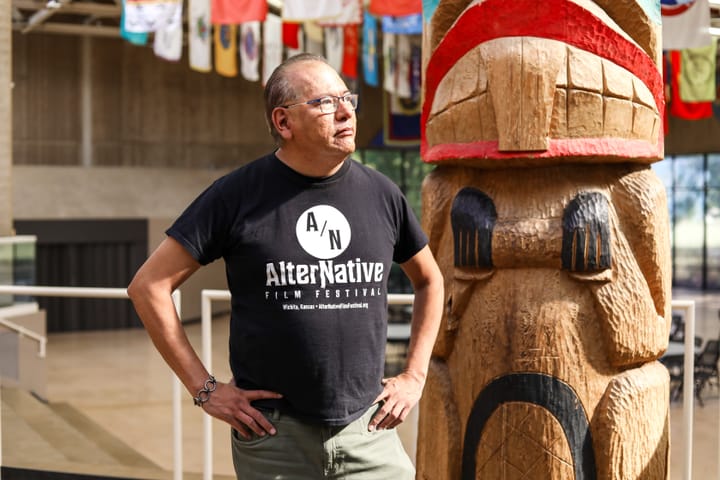Four Wichita State thesis shows offer unexpected challenges, pleasures
A look at exhibitions by Wichita State Master of Fine Arts students Zoë Gillis, Scott Jones, Mollykate Geddis, and Anthony Corraro
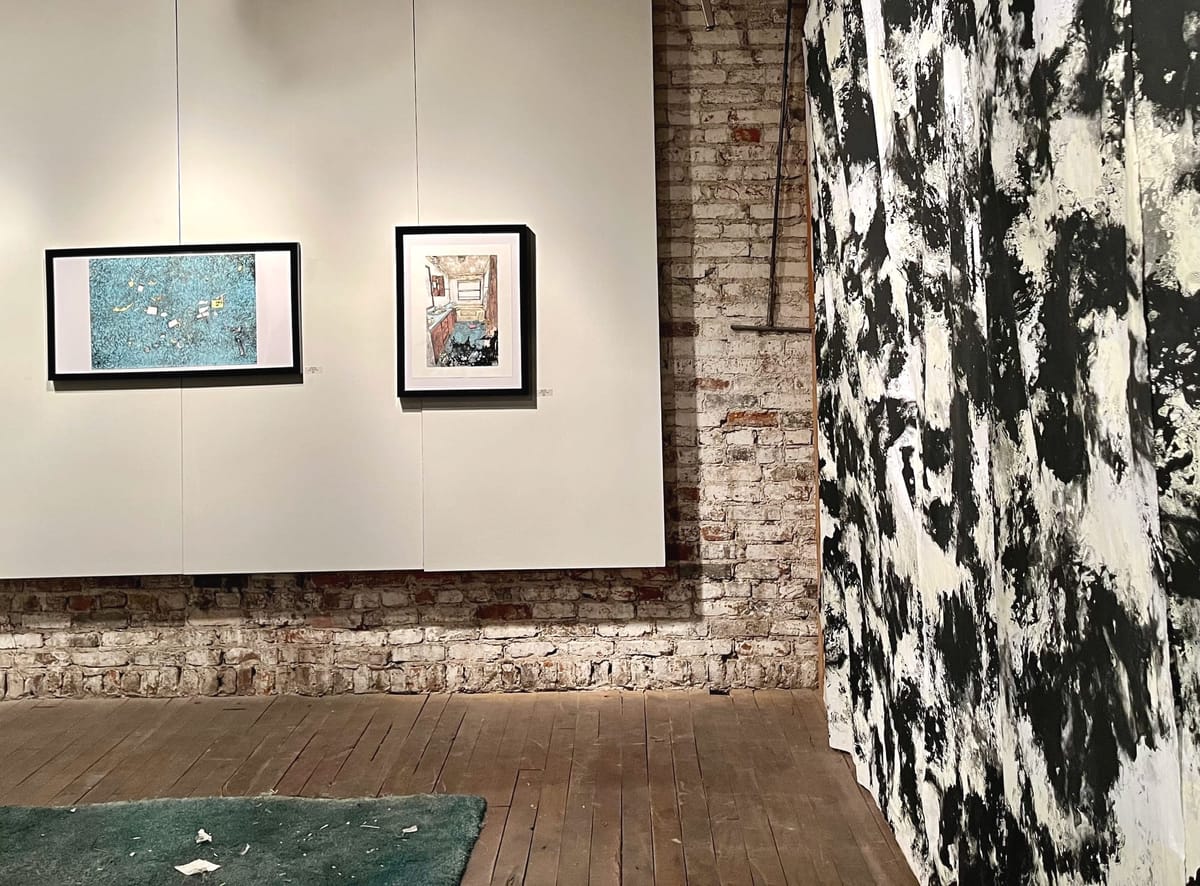
Since March, four students in Wichita State’s School of Art, Design and Creative Industries have presented thesis exhibitions, each the culmination of three years of graduate work.
The shows challenge viewers in different ways: Three out of the four require visitors to negotiate the gallery space in an atypical manner, and each artist pushes their respective medium in new directions. Two exhibitions are no longer on view, but there’s still time to see “Out in the Open” (through April 26) and "Reclaimed: Exploring Empathy Through Gesture” (through April 16).
Our free email newsletter is like having a friend who always knows what's happening
Get the scoop on Wichita’s arts & culture scene: events, news, artist opportunities, and more. Free, weekly & worth your while.
No spam. Unsubscribe anytime.
“Out in the Open,” Zoë Gillis
April 5-26, Bild Lab at Fisch Haus, 524 S. Commerce St. in Wichita
Zoë Gillis grew up in poverty, raised by parents who were (to use the artist’s term) addicts. In her thesis exhibition, she grapples with these realities through an installation, a series of screen prints, and a video about her childhood home.
“Out in the Open” is installed at Bild Lab, the Fisch Haus’ smaller, second-story exhibition space. At the entrance is a small section of blue carpet displayed on a low plinth. A much larger version, which visitors may step on, covers the floor at the far end of the gallery. Both high-pile carpet fragments are scattered with what, at first glance, looks like trash: hand-traced recreations of Walmart and Braum’s receipts, screen-printed cigarette butts and boxes. The artist told me an earlier version of the installation looked so realistic that a member of the Wichita State custodial staff vacuumed it up.
Screen prints line the gallery walls, each a scene from Gillis’ old house, with that distinctive and slightly horrifying 1980s blue carpet an element in most of them. After laboriously printing a highly detailed rendering, the artist applied a final, free-form layer of black ink. These appear to stain the images, encroaching on their borders and spreading into the rooms like black mold.
Above the staircase, a video projection of Gillis’ disembodied hands pouring dye onto and rubbing it into a section of blue carpet lends an ASMR-style soundtrack to the exhibition. To me, the video felt a bit superfluous at first. But, like the overlays of black ink, it gives viewers a window into the artist’s attitude toward this whole enterprise. The carpet fragments are not bizarre keepsakes excised from an old house — Gillis recreated them in her studio. Neither can her prints give us a clear picture of what it was like to grow up in her home. Time and memory (and hurt and longing) have transformed that landscape.
When Gillis was a girl, her family lived below the poverty line. Her parents struggled with substance abuse. These are facts. Beyond that, the picture gets blurry. She might invite us to step on her recreated carpet, but Gillis can't take us into the past with her. After all, as “Out in the Open” acknowledges, she can’t go there herself.
A closing reception for “Out in the Open” will take place 6-9 p.m. on Friday, April 26. Please note that the gallery is only accessible by stairs.
Learn more
- MFA spotlight on Zoë Gillis (Wichita State School of Art, Design and Creative Industries)
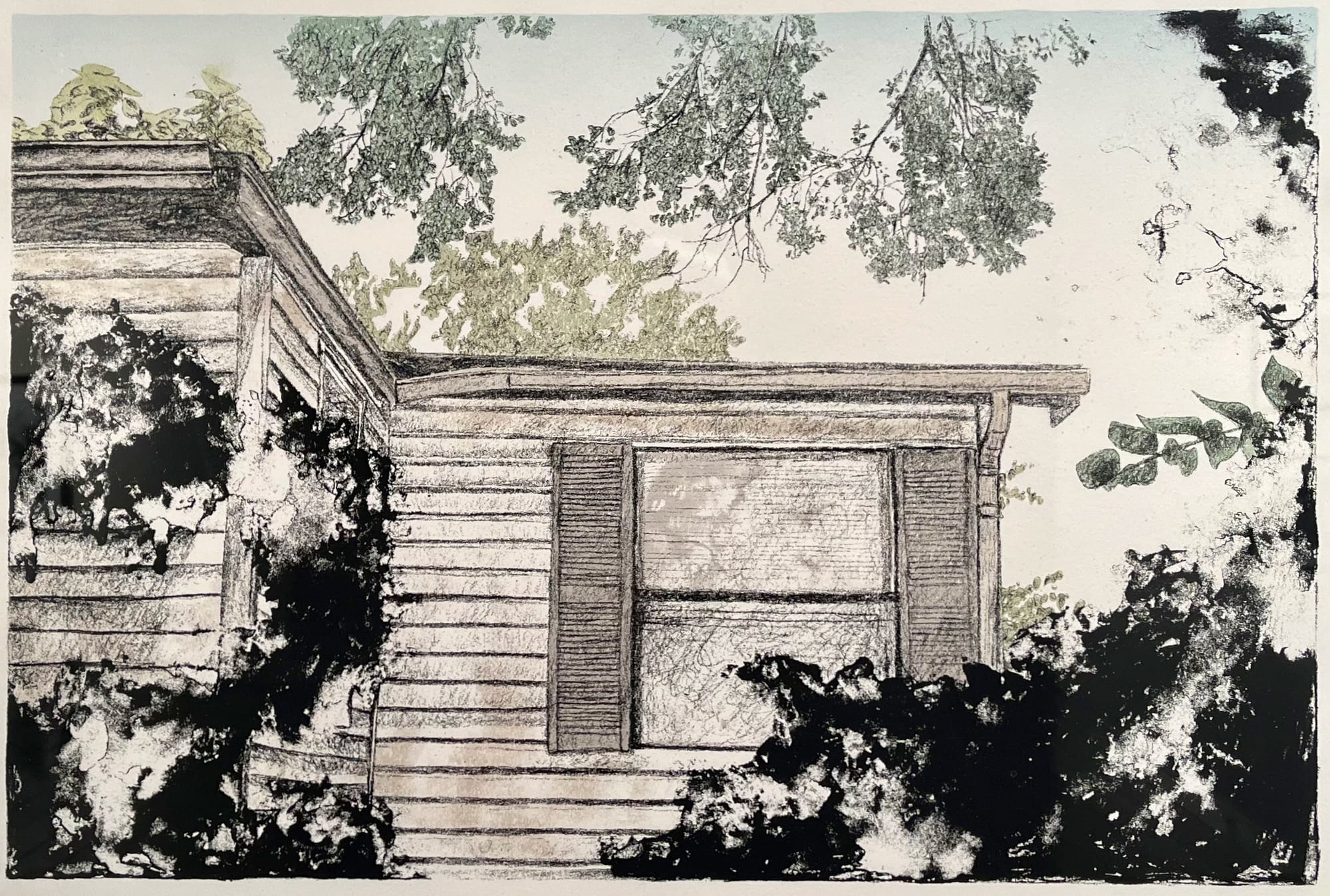
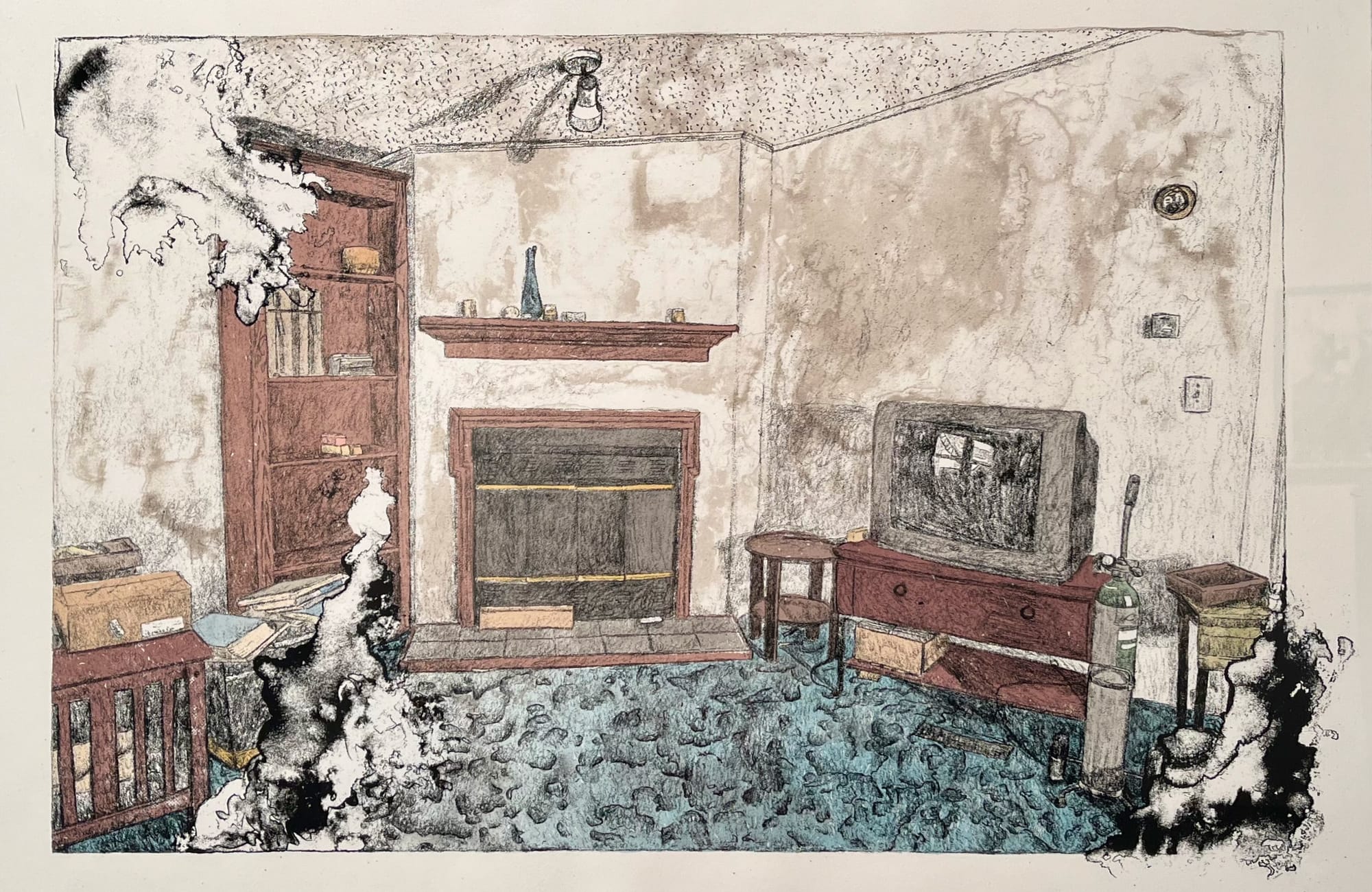
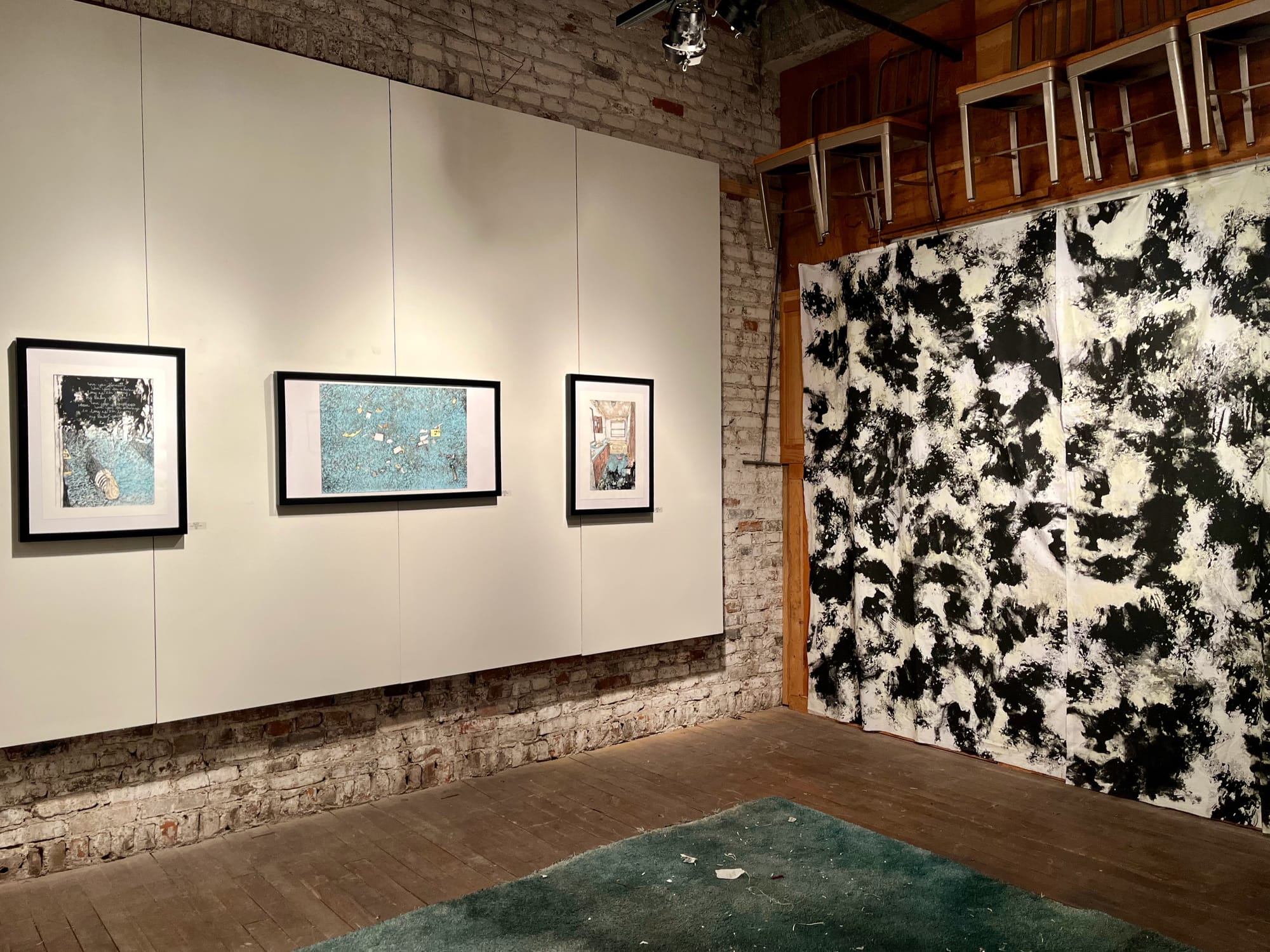
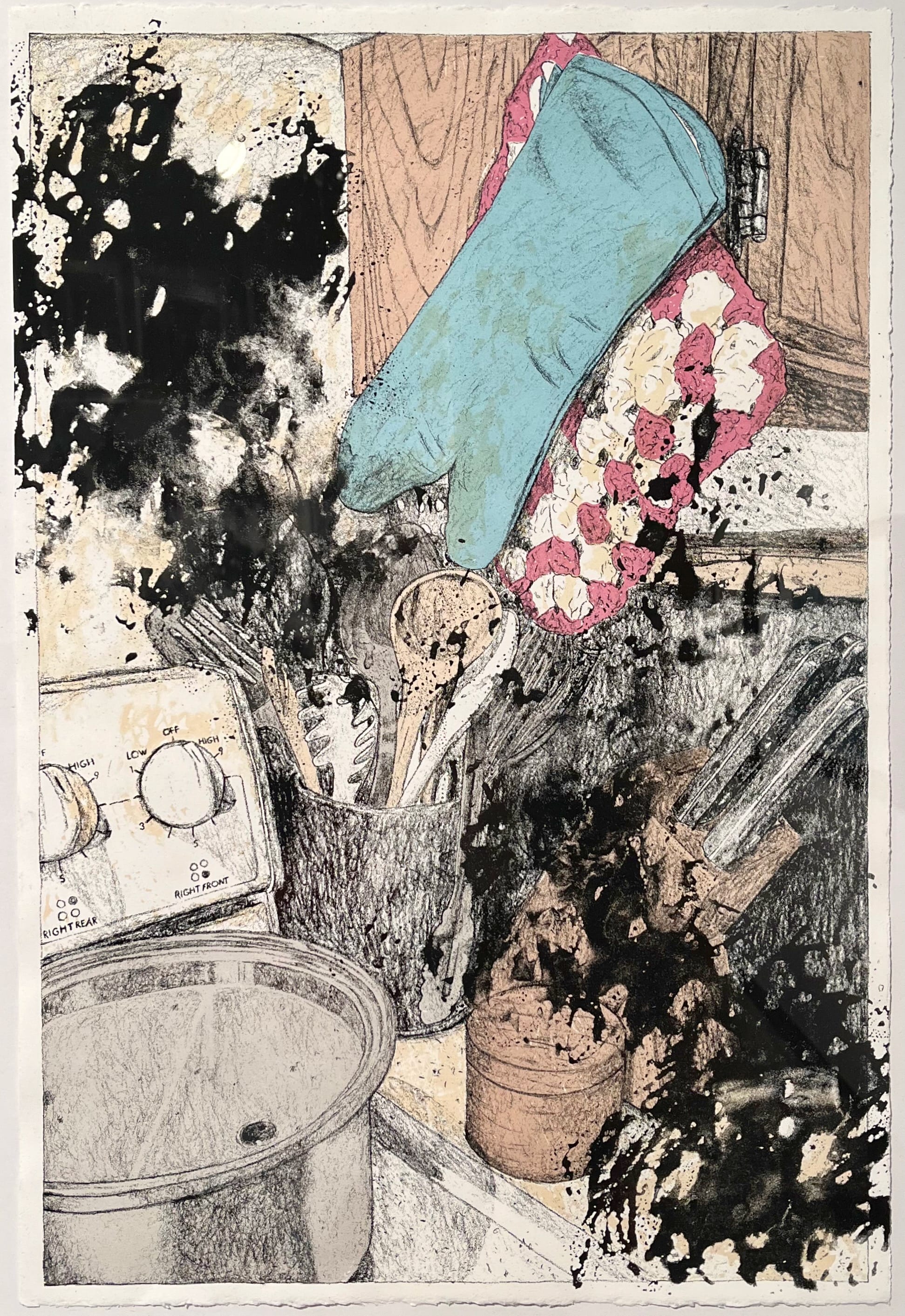
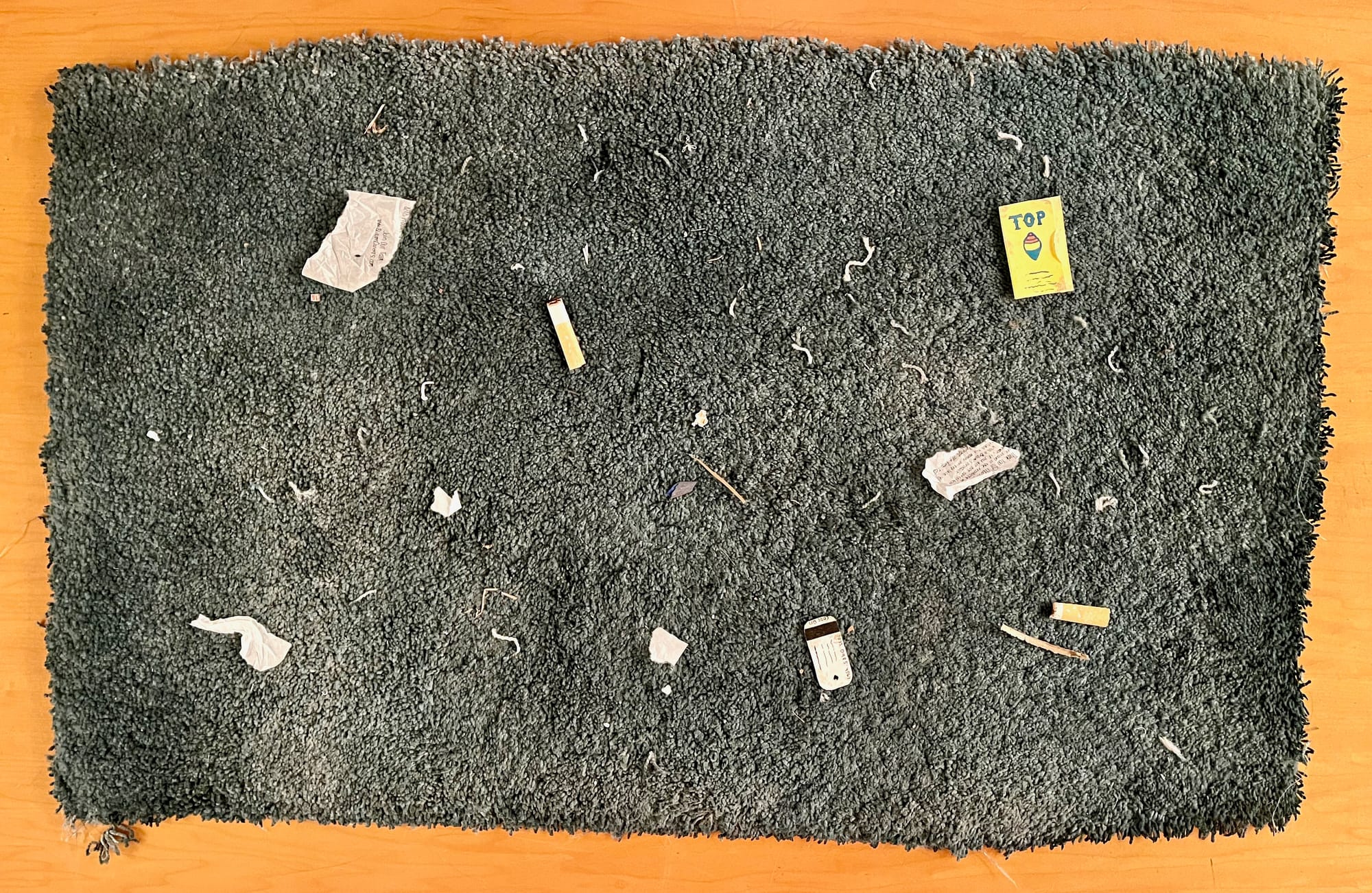
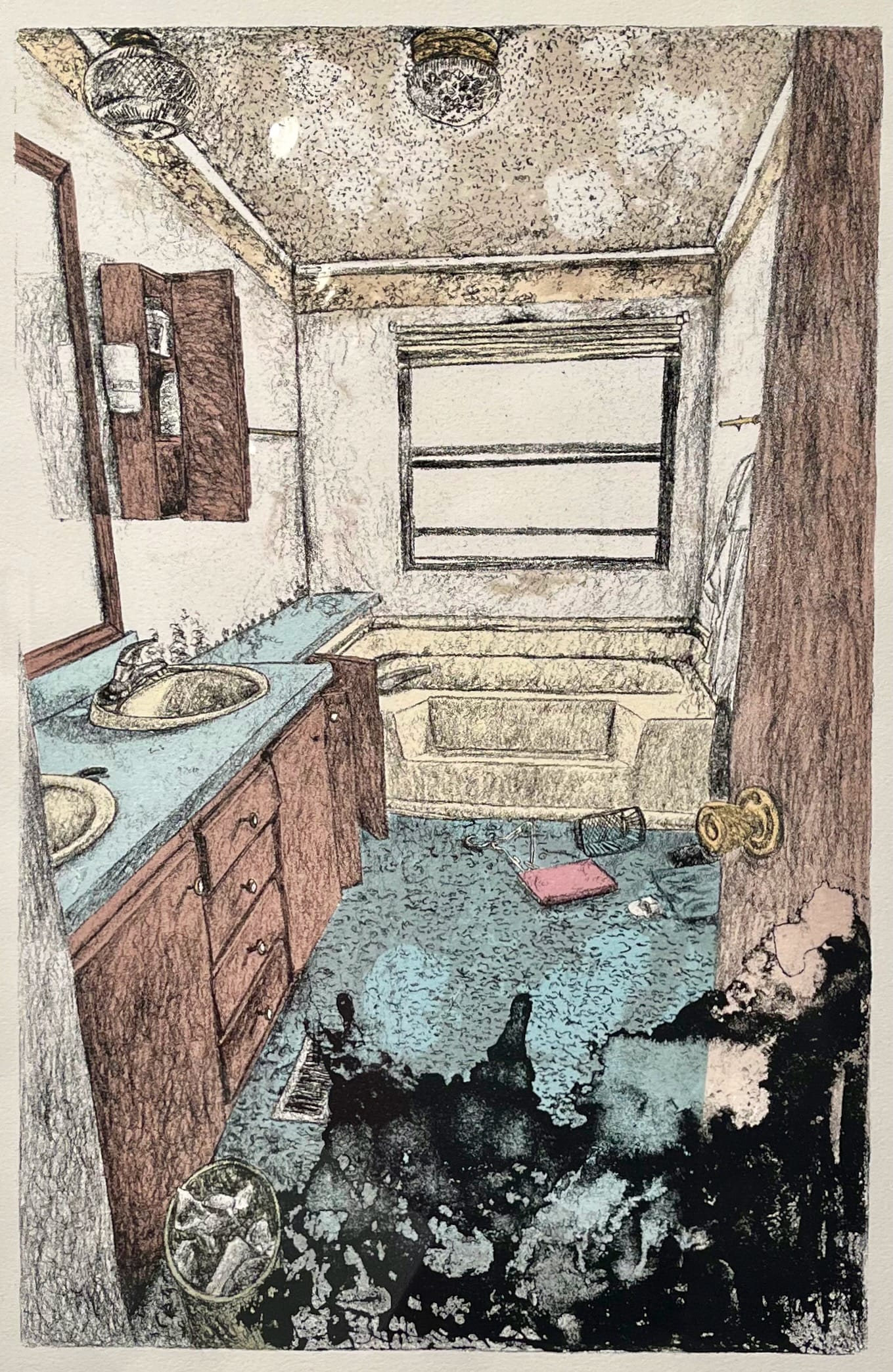
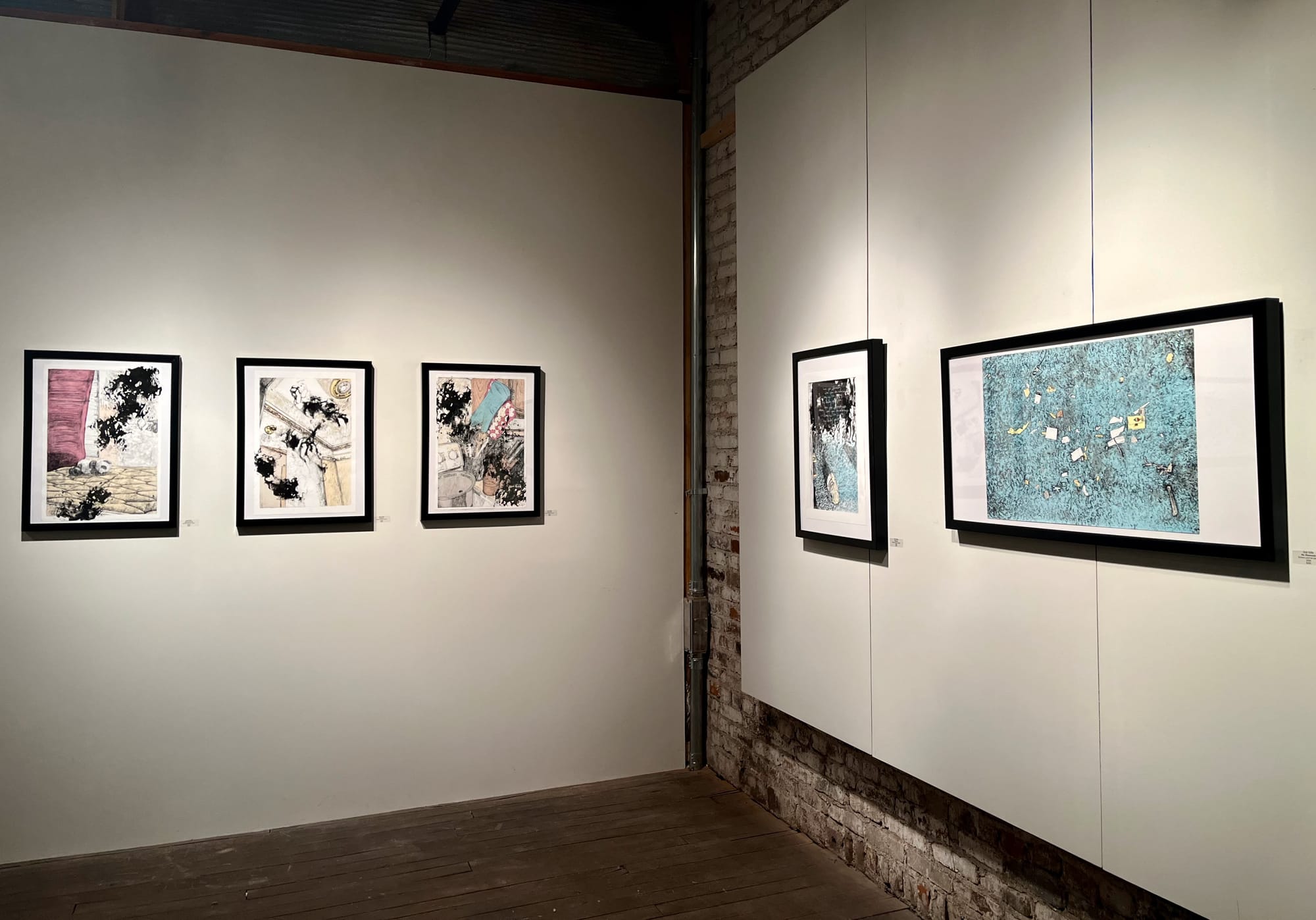
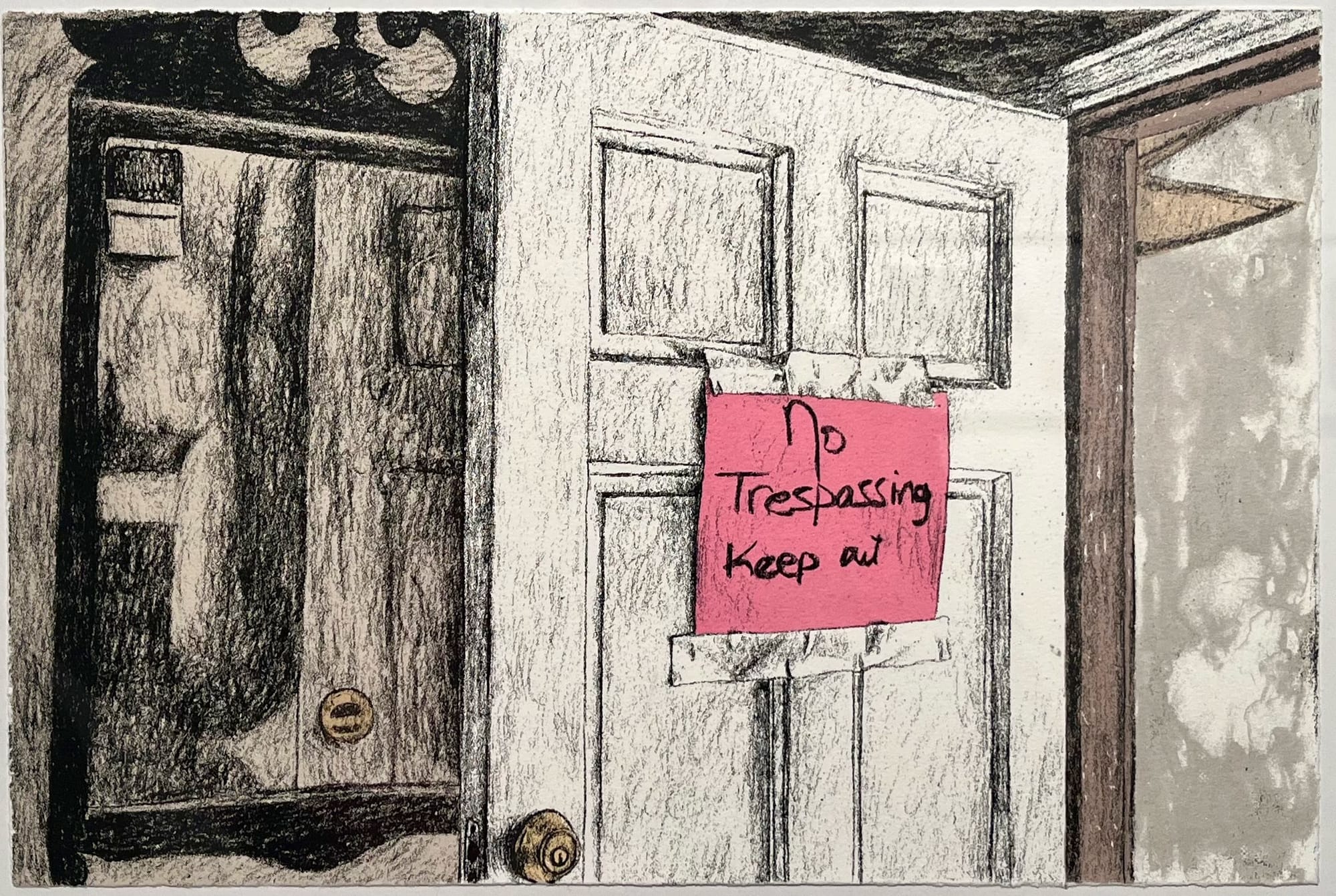
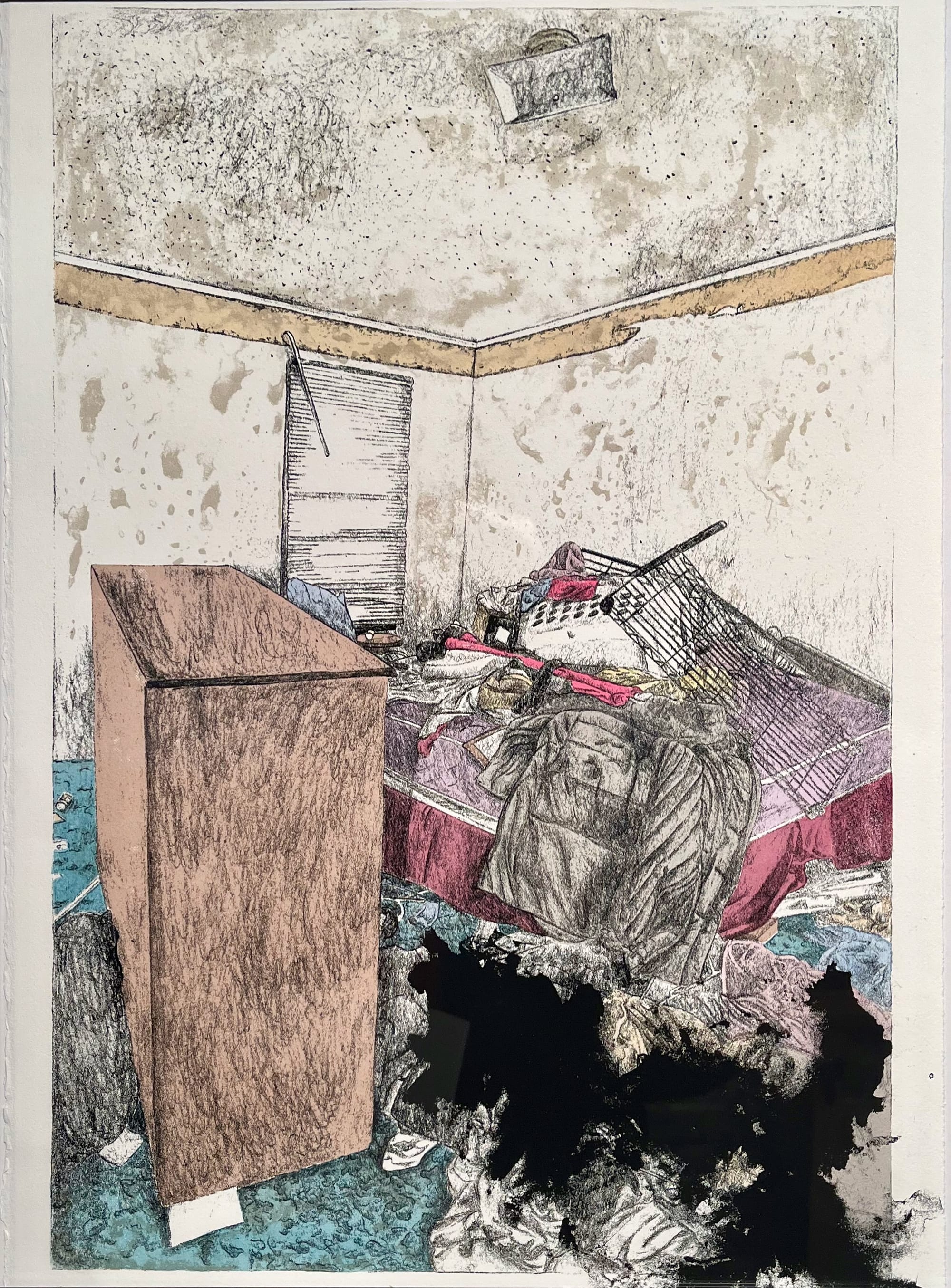
Images from Zoë Gillis' MFA show "Out in the Open," from top left: “Convergence,” screen print on paper, 2023; “Acquiescence,” screen print on paper, 2023; Bild Lab installation view including blue carpet, screen prints, and a curtain mono-printed with the black "stains" from the screen-print series; “Dissolution,” screen print on paper, 2023; “Immaterial," screen print on paper, 2023; a small fragment of blue carpet littered with handmade "trash" greets visitors, welcome-mat-like, at the front of the gallery; another Bild Lab installation view; “Keep Out,” screen print on paper, 2023; , “Extinction (1),” screen print on paper, 2023
"Reclaimed: Exploring Empathy Through Gesture," Scott Jones
April 10-16, Clayton Staples Gallery in McKnight Art Center on the Wichita State campus, 1845 Fairmount St.
The nine pieces in “Reclaimed: Exploring Empathy Through Gesture,” on view in the Clayton Staples Gallery through Tuesday, April 16, look as though they could be functional. At the same time, they seem unlikely vehicles for floral arrangements or fruit. They’re vessels that don’t require a purpose.
While each piece has a formal relationship to the others, Jones’ exploration of color, pattern, and form results in nine distinct works that invite the viewer to generate their own interpretations. (Does “Born Yesterday” reference Spider-Man? Probably not, but that’s where my mind went.)
The ceramics’ sculptural forms feel very much in dialogue with the work of Ted Adler, Wichita State professor of ceramic media, as well as other graduates of WSU’s ceramics program. In some works, such as “Why are you blue?” and (especially) “Daddy Dropoff,” Jones uses decals to apply patterns in a way that reminds me just a little of the work of Sam Chung.
The most distinctive aspect of “Reclaimed” is the drippy effect Jones achieves. This technique manifests differently depending on the piece. In “Substance,” the drips appear to defy gravity, shooting upward in a mind-bending manner. A juicy green ceramic overlay nearly dribbles onto (but doesn’t quite reach) the pedestal that “Dual Dynamics” rests on. With the strange, oozing quality of these forms, Jones manages to carve out his own visual territory.
A closing reception for “Reclaimed: Exploring Empathy Through Gesture” will take place 5-7 p.m. on Tuesday, April 16. The gallery is open to the public 9 a.m.-5 p.m. Monday-Friday.
Learn more
- MFA spotlight on Scott Jones (Wichita State School of Art, Design and Creative Industries)
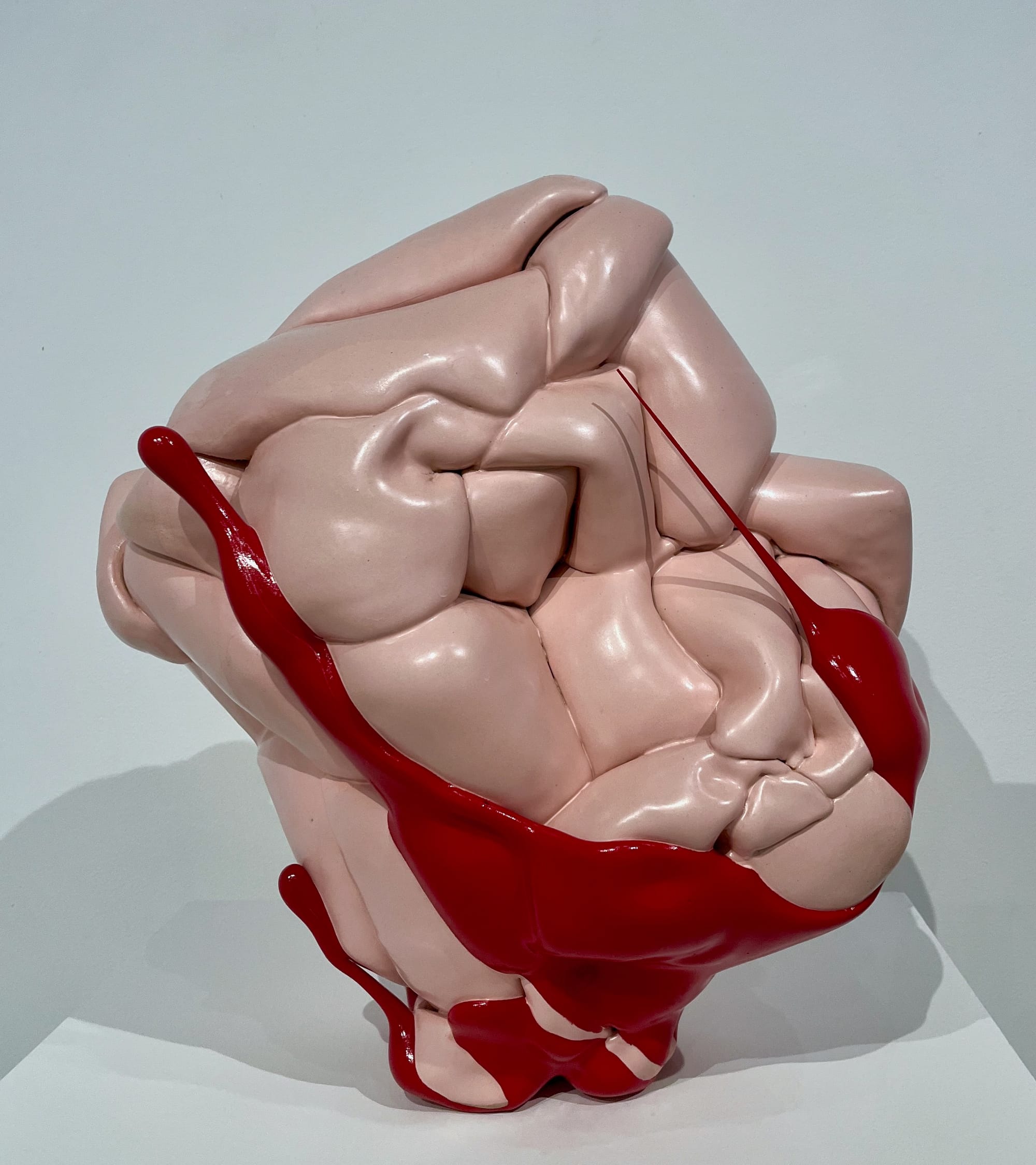
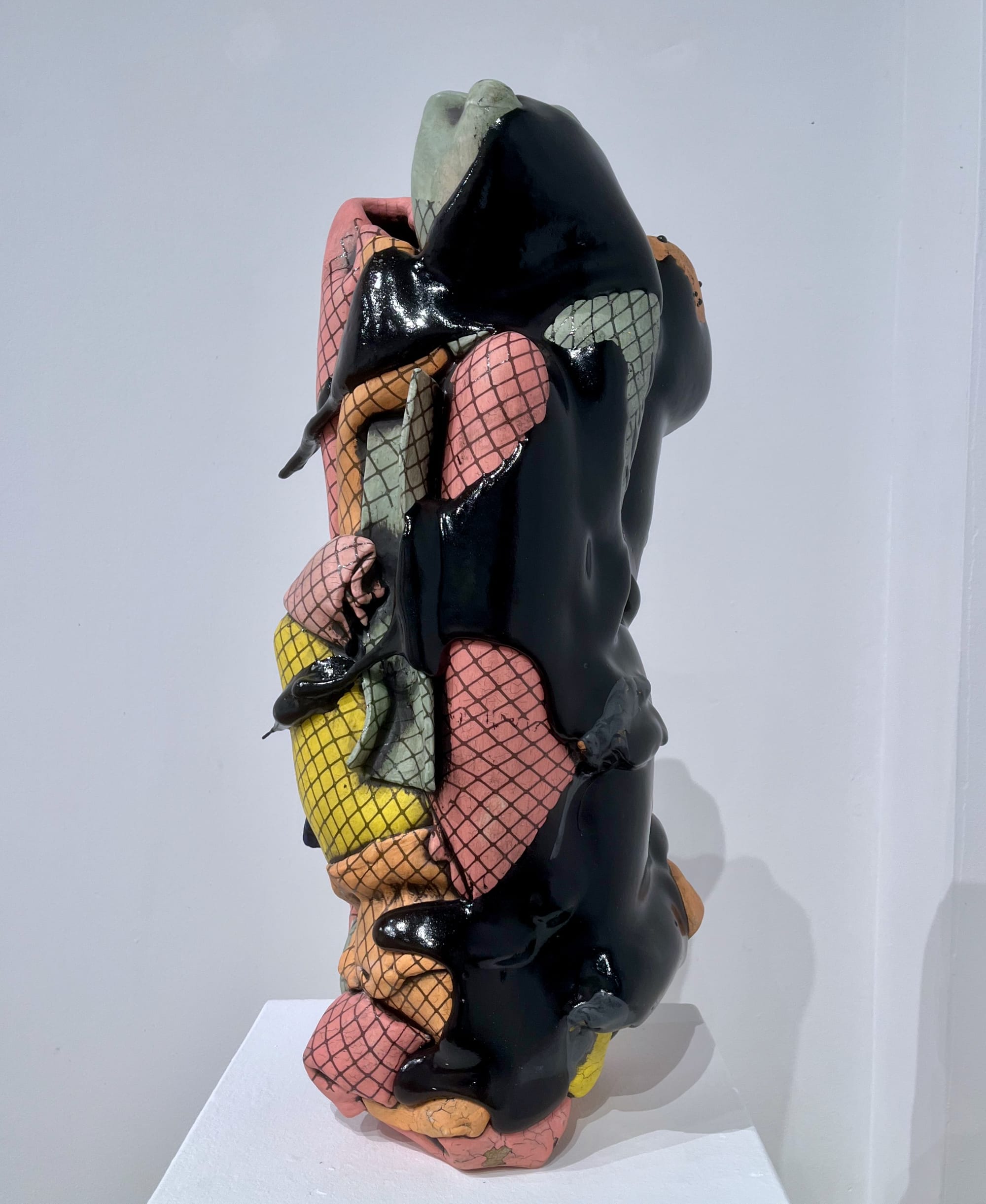
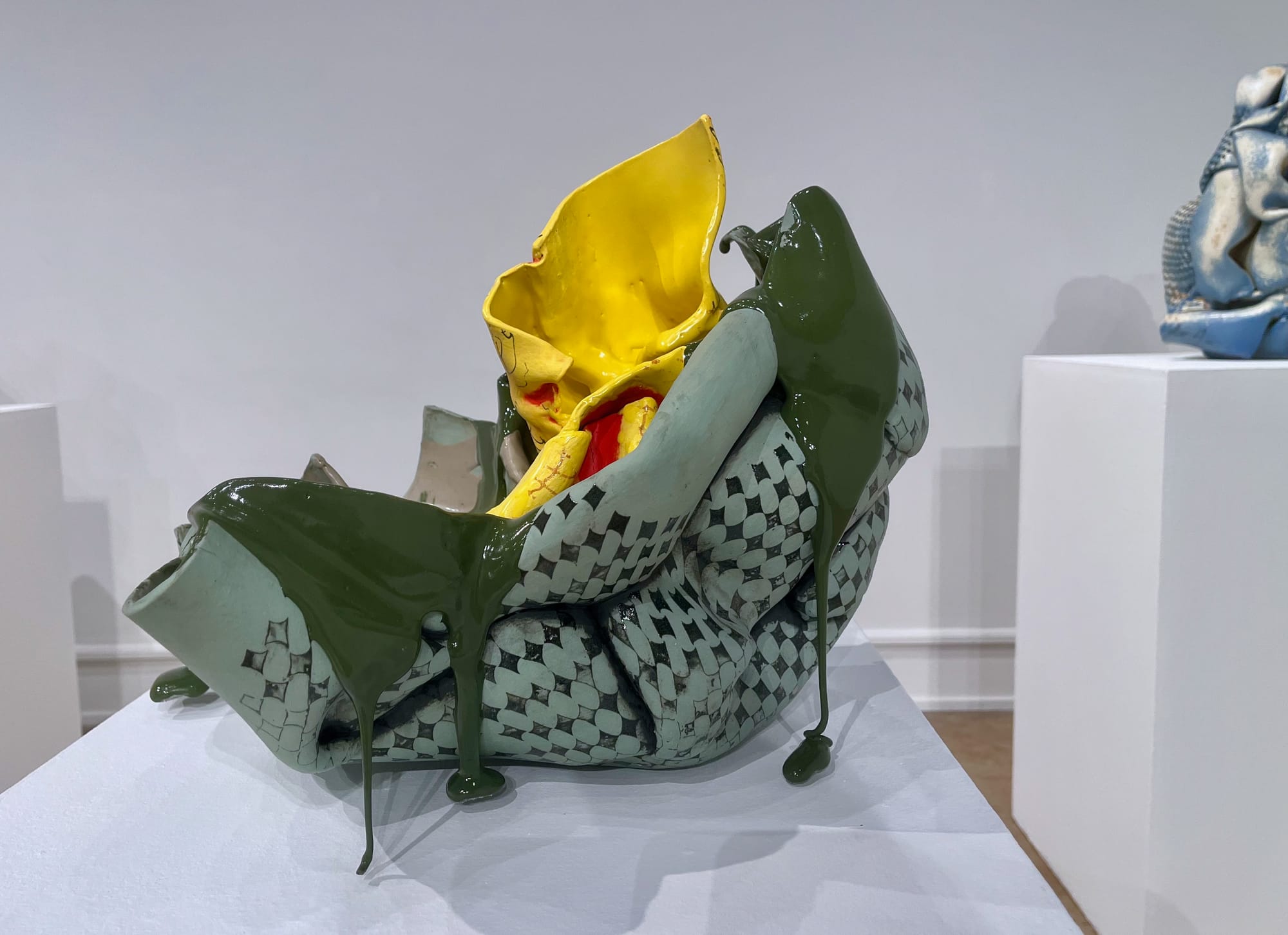
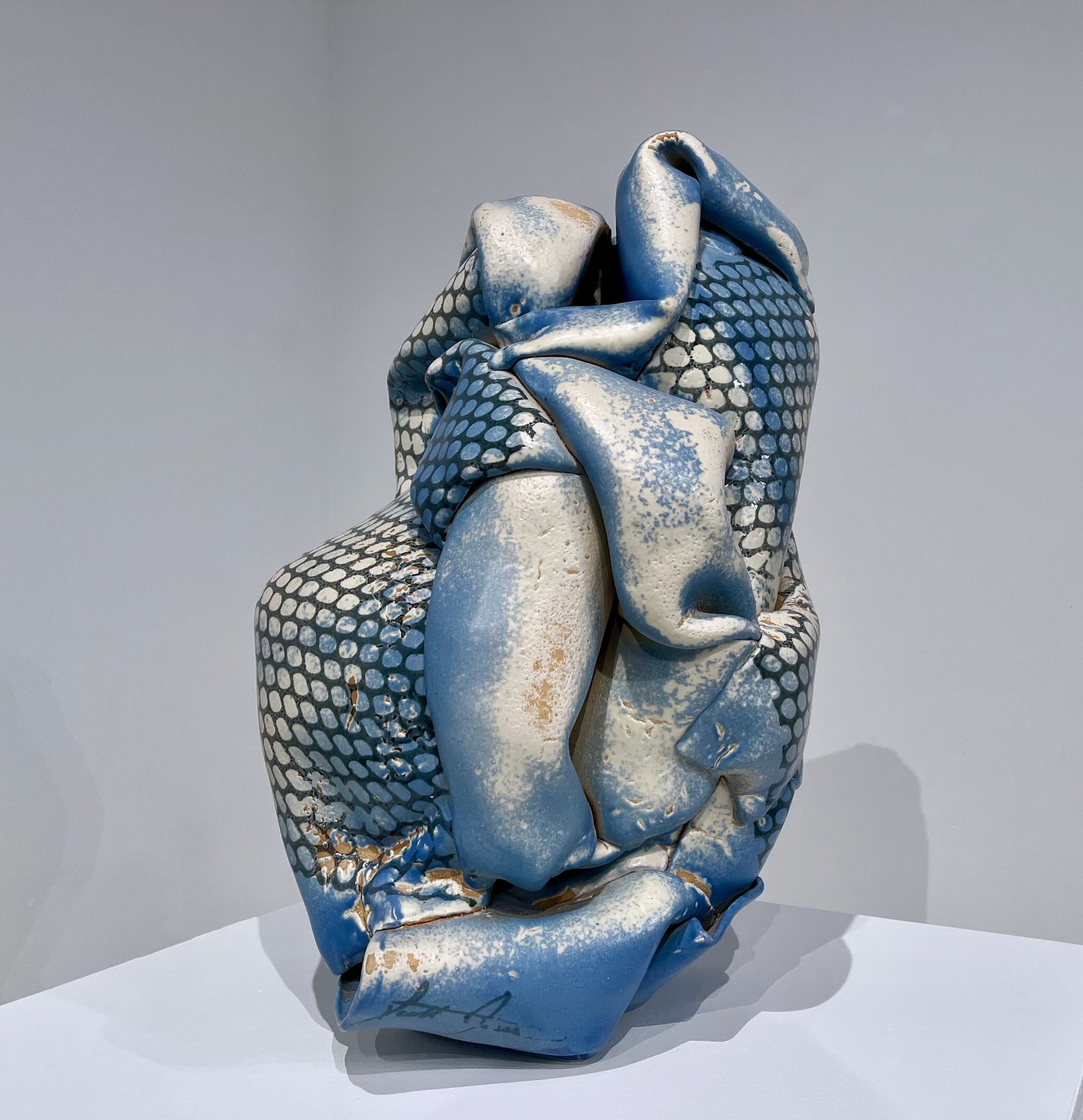
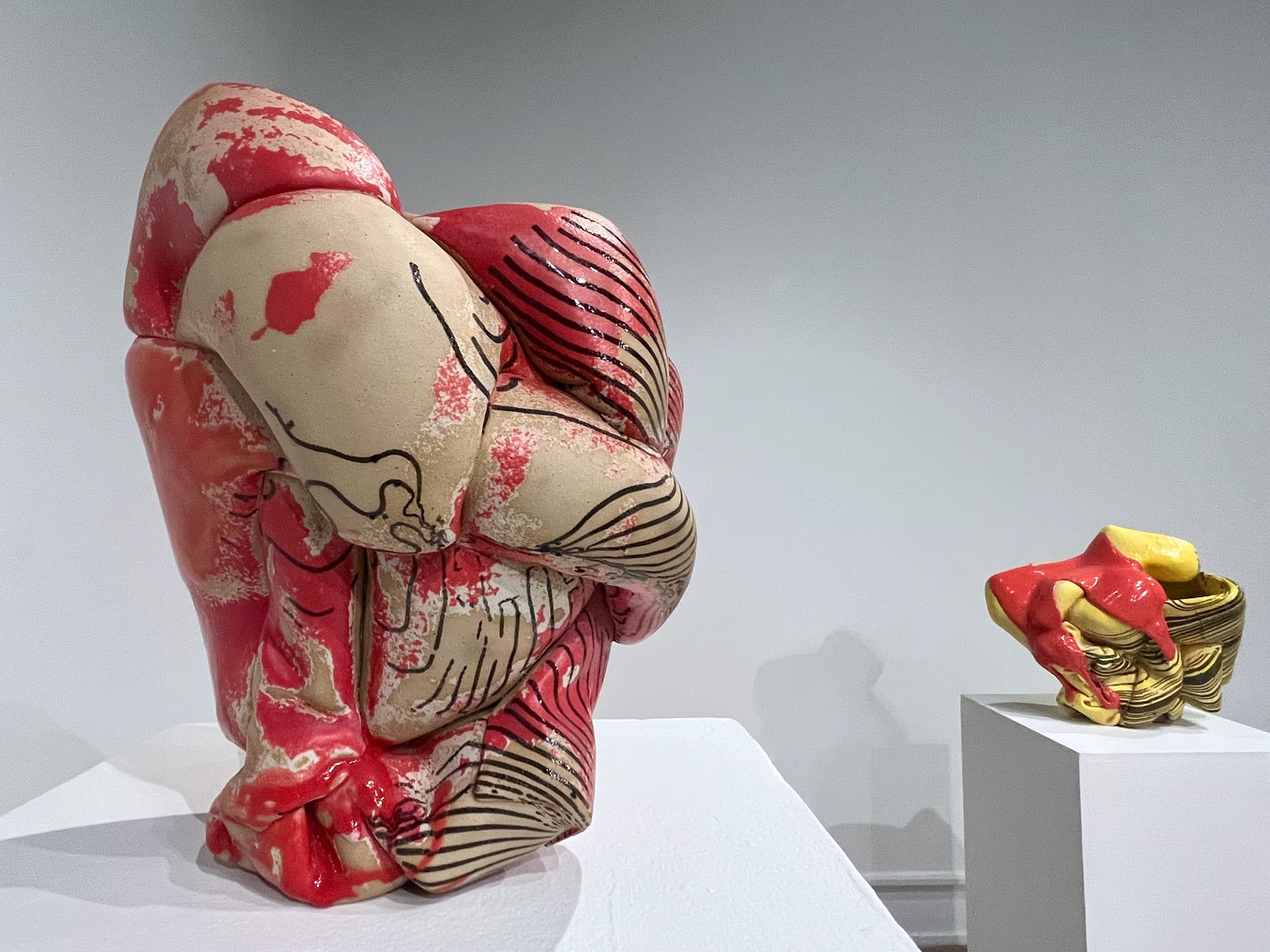

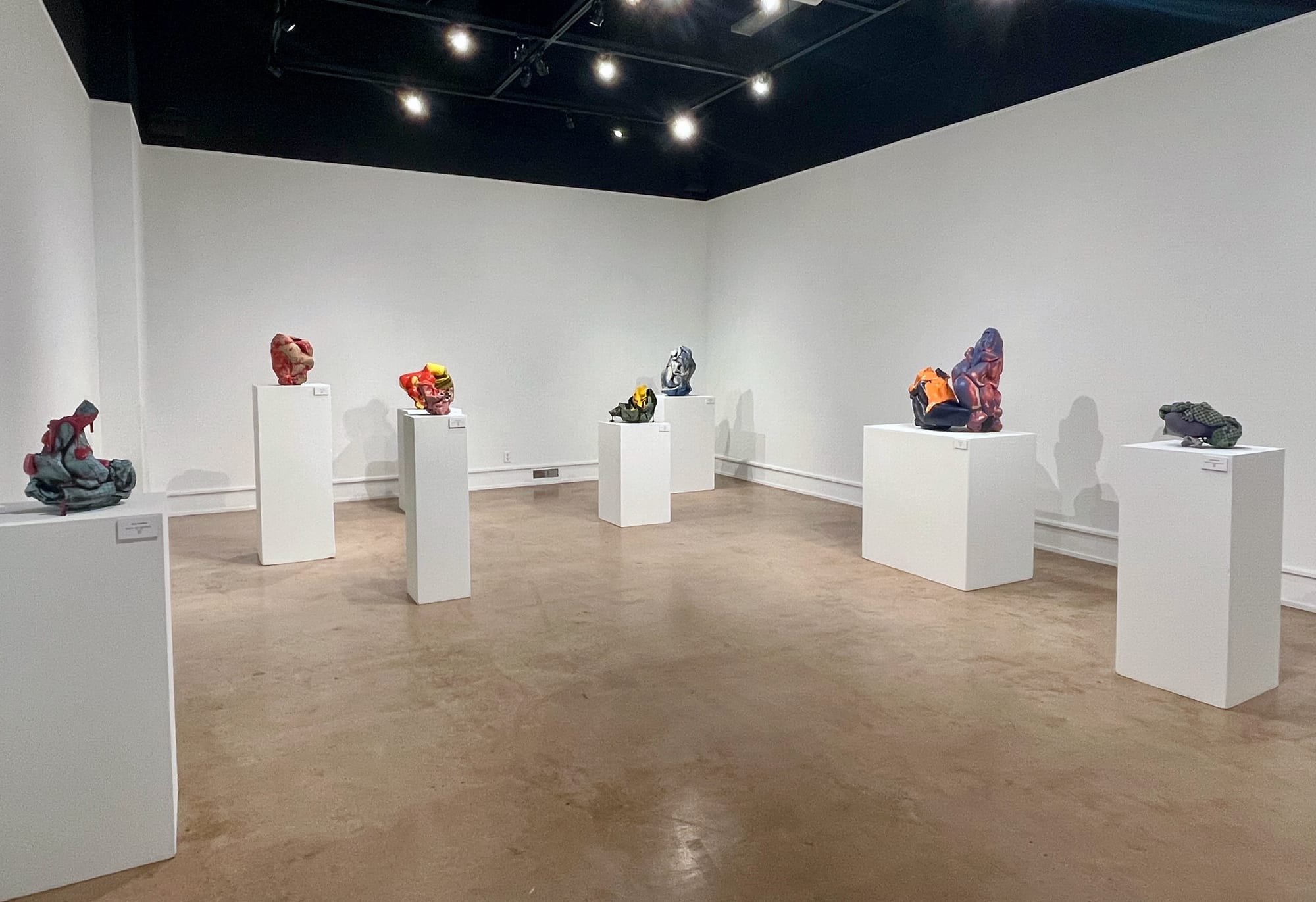
Images from Scott Jones' thesis exhibition "Reclaimed: Exploring Empathy Through Gesture," from top left: "Substance," ceramics, 21 by 19 inches, 2024; "Socked," ceramics, hydrodipped decal, 25 by 11 inches, 2024; "Nestled," ceramics, hydrodipped decal, 13 by 17 inches, 2024; "Why are you blue?" ceramics, hydrodipped decal, 22 by 15 inches, 2023; "Daddy Dropoff, ceramics, hydrodipped decal, 2023; "Born Yesterday," ceramics, hydrodipped decal, 12 by 10 inches, 2024.
“Visual Pleasure,” Mollykate Geddis
March 29-April 3, Clayton Staples Gallery in McKnight Art Center, Wichita State campus, 1845 Fairmount St.
“Visual Pleasure” is a bit of a challenge to view, which is entirely to its credit.
The fiber and ceramic installation requires that visitors make their own path around the Clayton Staples Gallery. In her thesis exhibition, Geddis has declined to direct us. When I visited the gallery with a friend, we nervously ducked under swags of granny squares and tiptoed over waves of yarn before giving ourselves over to its advertised pleasures.
Once you negotiate its structure, the exhibition is a delight to inhabit. Geddis and members of her community crocheted hundreds of granny squares in a distinctive palette of teal, gold, celadon, maroon, gray, and pink. The textile squares, along with ceramic pieces that loosely mimic their crocheted forms, hang, pennant-like, from the ceiling and walls. Individual pieces of yarn venture out on their own, hanging from the ceiling, crawling up walls, and undulating on the floor. The different textures are so inviting, it’s hard to keep your hands to yourself.
The traditional white gallery walls feel too sterile to contain the exuberance of “Visual Pleasure,”— the contrast so great it’s almost painful. Absent the constraints of an academic schedule and tight gallery turnaround, I would be curious to see how the installation might be reiterated in a new way. I’d like to return to its disorienting world.
Learn More
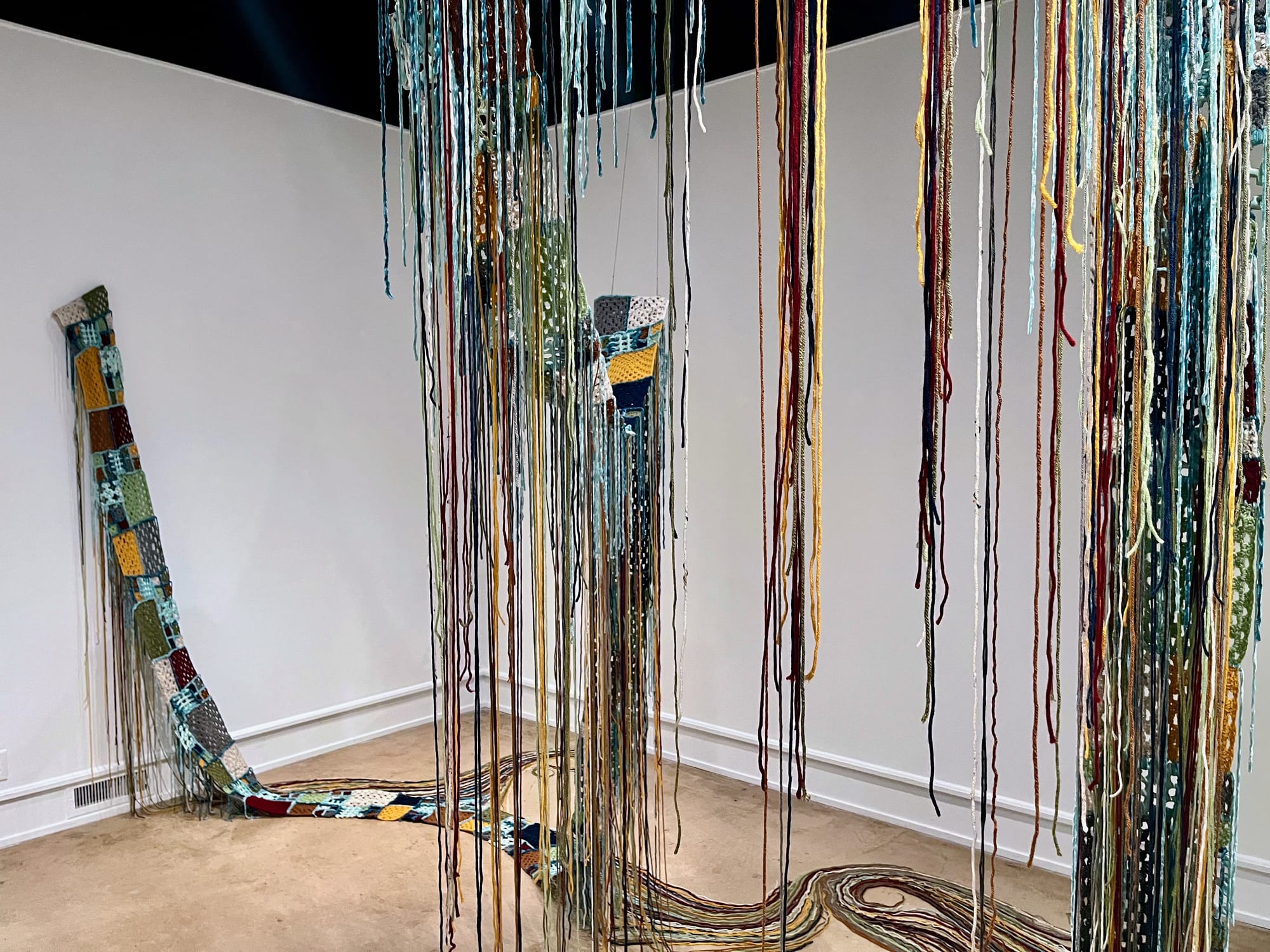
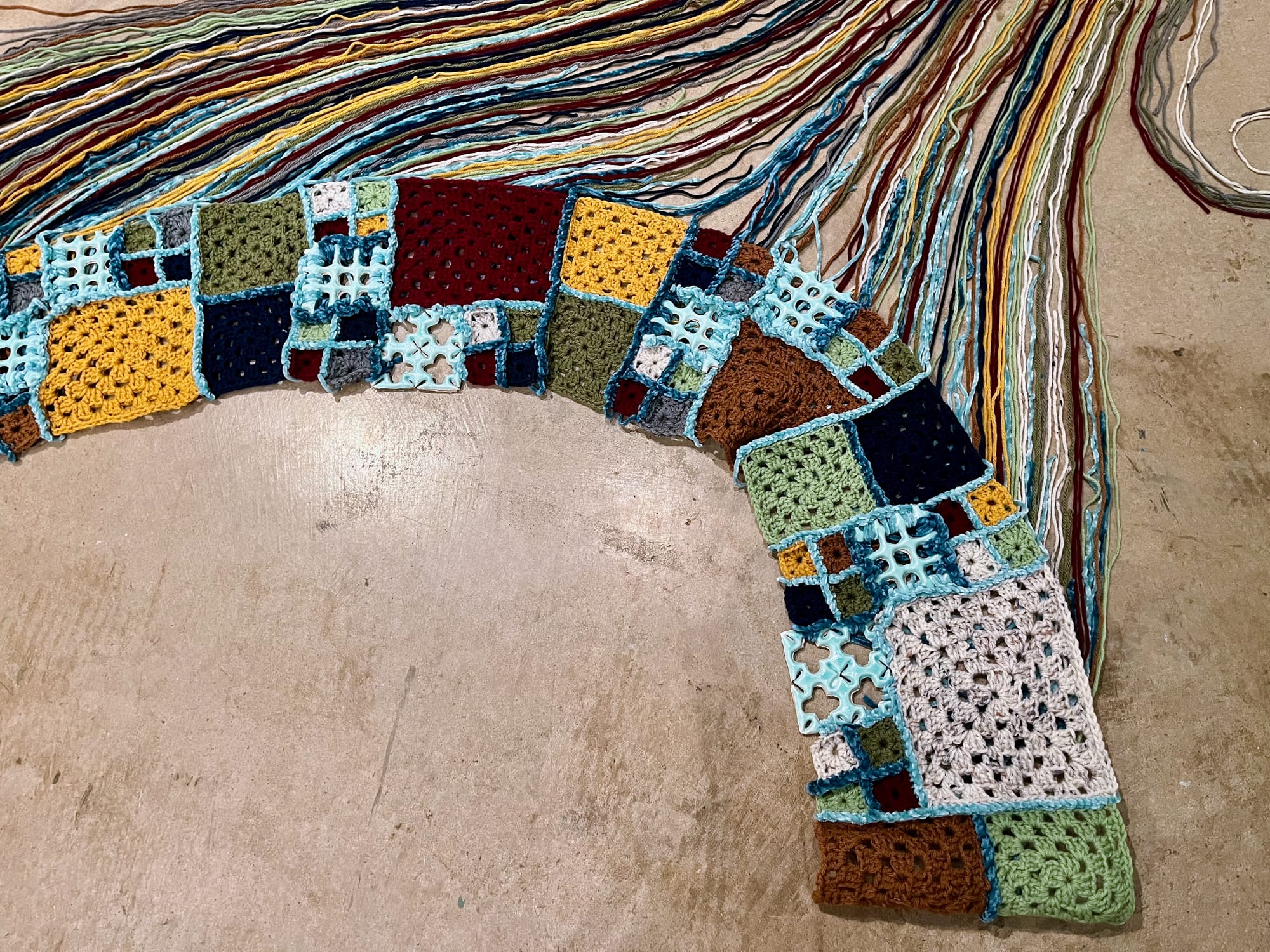
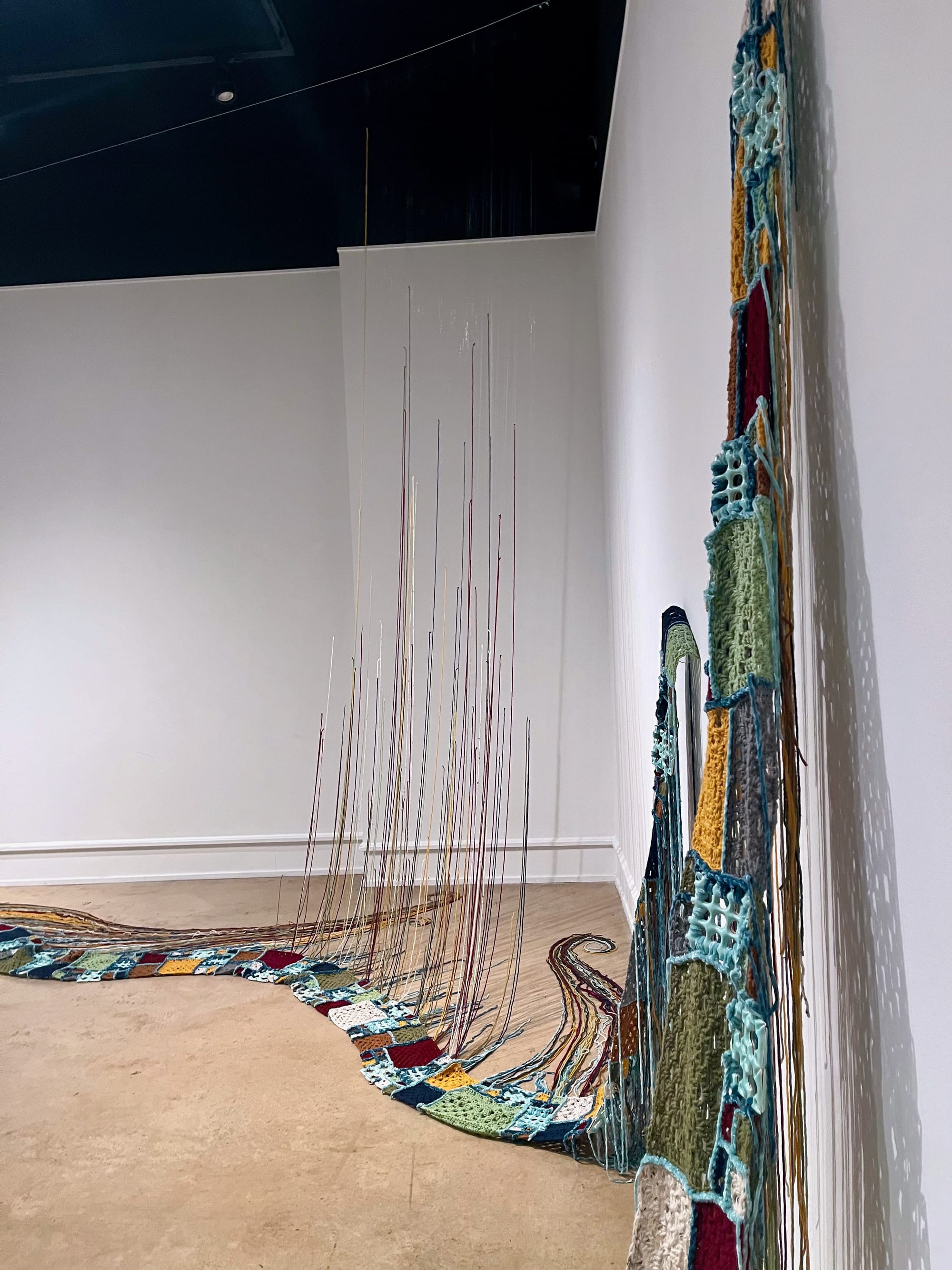
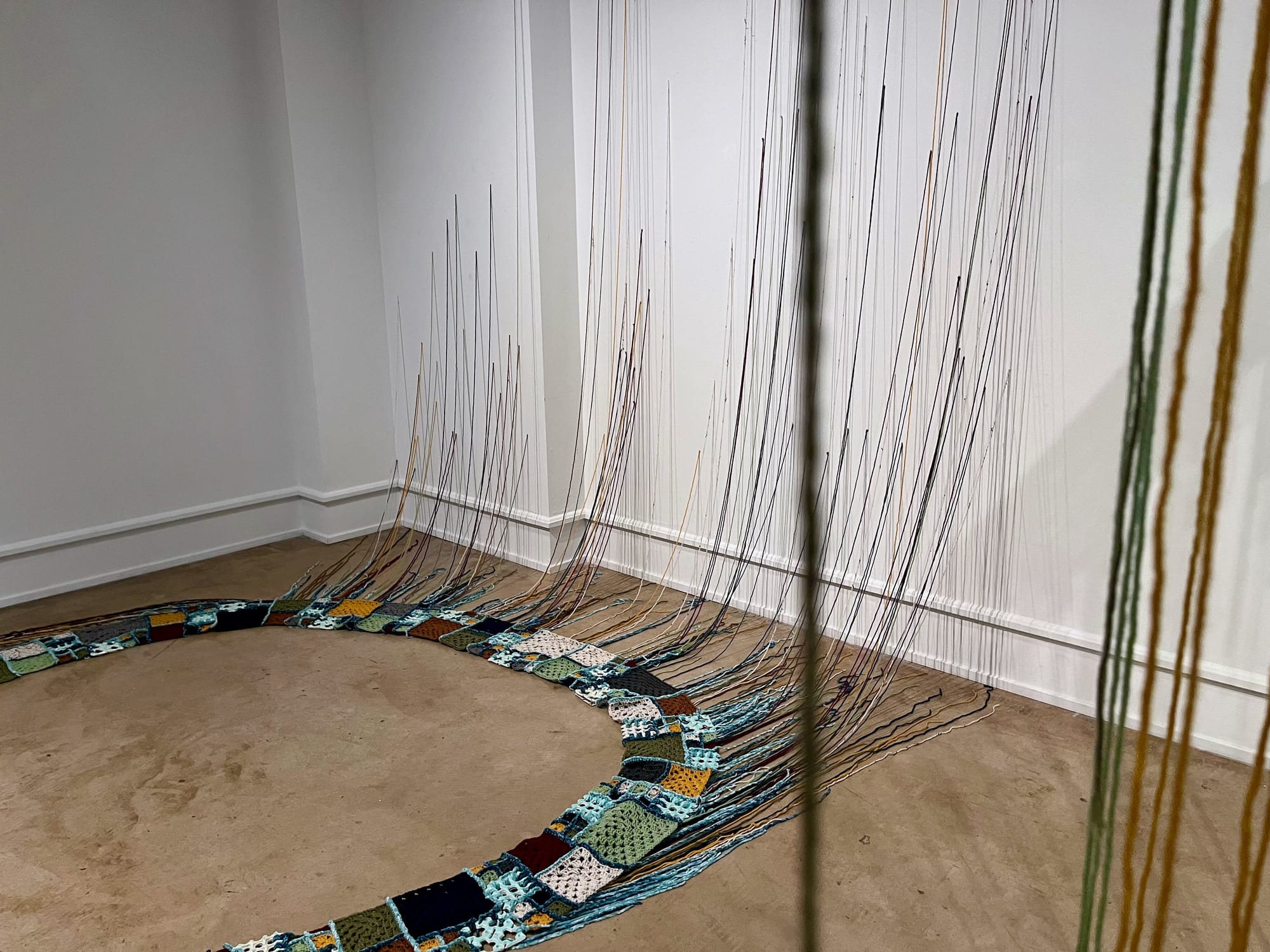
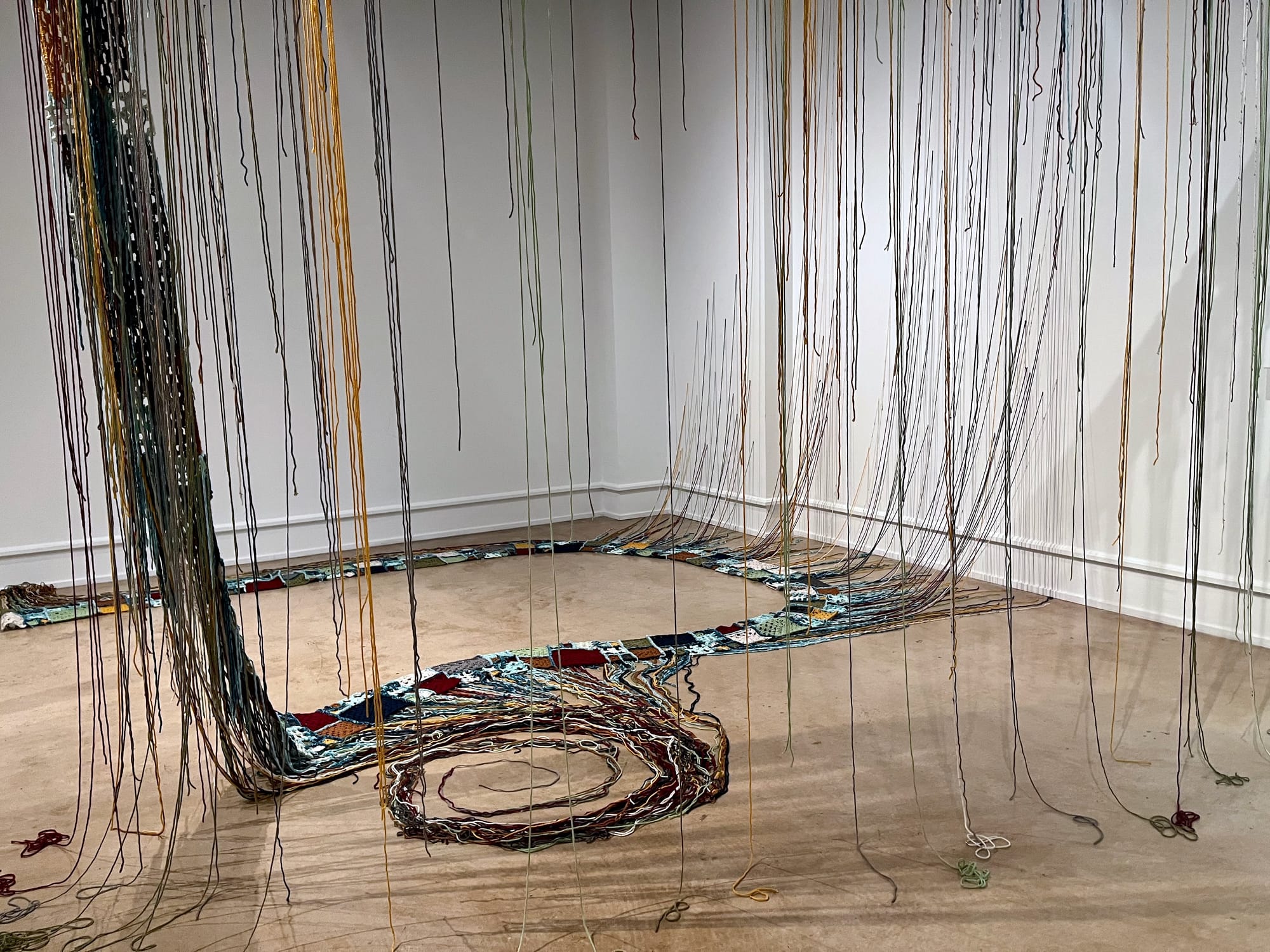
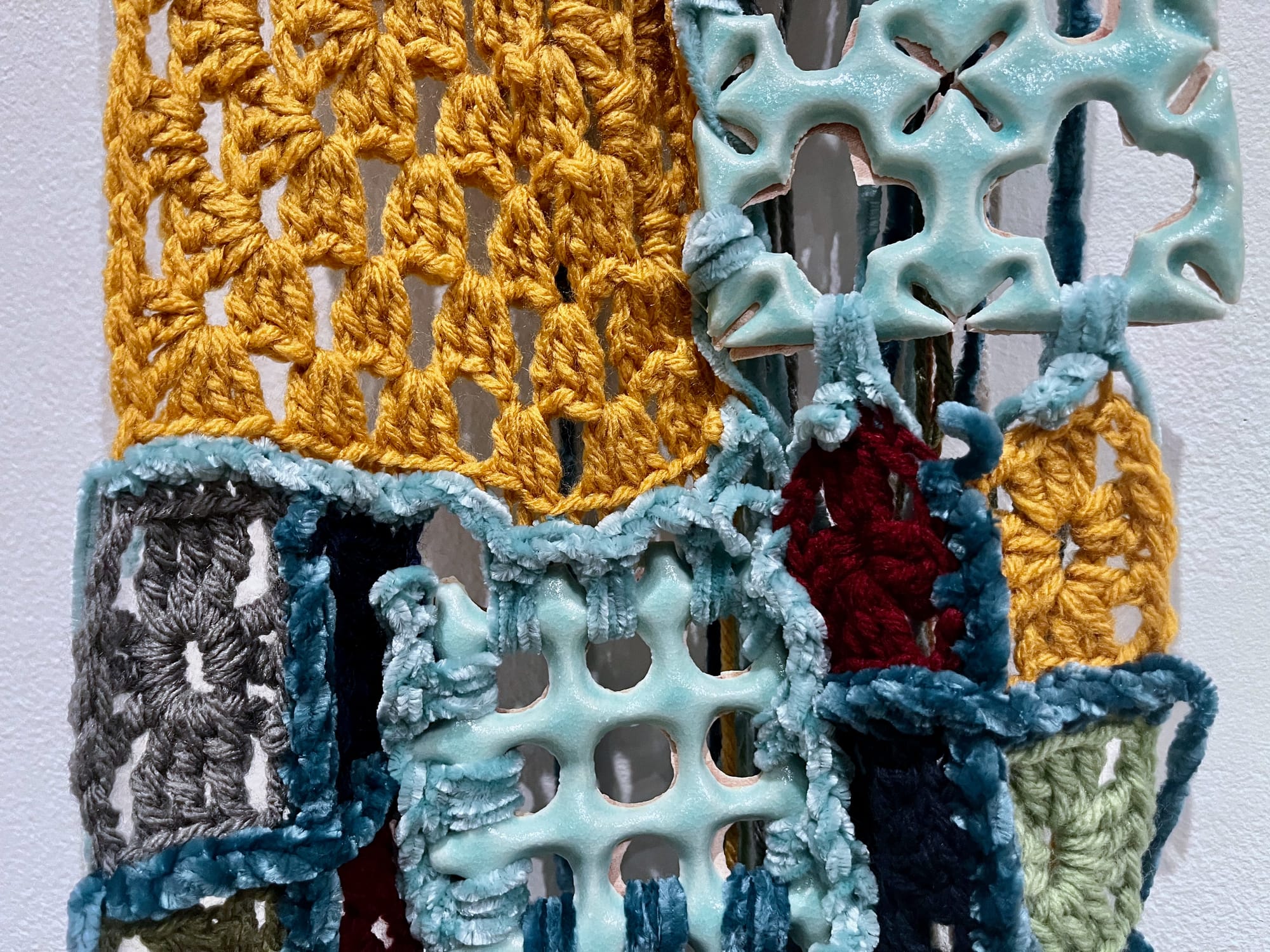
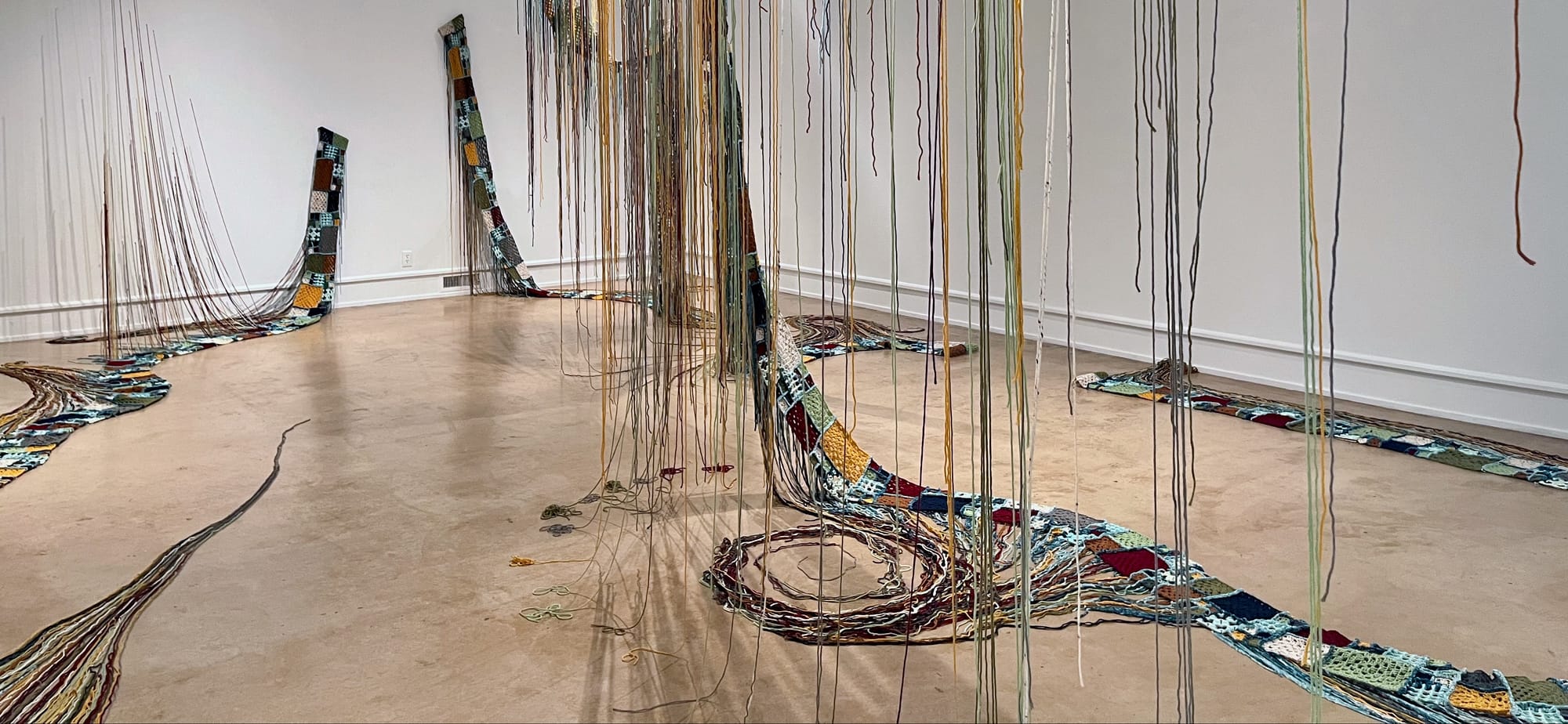
Images from "Visual Pleasure," a ceramic and textile installation by Mollykate Geddis.
“To Dust,” Anthony Corraro
March 18-22, Clayton Staples Gallery in McKnight Art Center, Wichita State campus, 1845 Fairmount St.
Anthony Corraro is so enamored with cleaning, he’s embedded the chore into his art practice. That has never been more evident than in “To Dust.” Except for a process video, every bit of work in his thesis exhibition, and even the artist statement, is made from dust he collected from sweeping his home and studio.
Corraro dyed the dust cyan, magenta, yellow and black, then followed a traditional screen-printing process to make images with the ephemeral material. At the close of the exhibition, the artist invited visitors to help sweep up the art.
Seven dust prints were installed on specially designed pedestals and on the floor of the Clayton Staples Gallery, which was open to the public for a week. A sign outside the door invited nervous visitors to use a mask to view the show (after all, an errant sneeze might have altered the work). I visited at the beginning and end of the exhibition run to see how the prints fared. Most were still largely intact, although the artist statement was a bit smudged and someone had left footprints on “Nexus.”
In originating a new way to print images, Corraro invites the criticism that the process is more interesting than the work itself. That feels inevitable, even fair. But his dust prints are quite lovely. Influenced by Buddhist design motifs, they also owe a visual debt to “Fantasia” and animation in general. Collectively, the prints convey the artist’s willingness to completely immerse himself in his own preoccupations. He shows us the path he took to get there, but Corraro arrives in a place all his own.
Learn more
- MFA spotlight on Anthony Corraro (Wichita State School of Art, Design and Creative Industries)
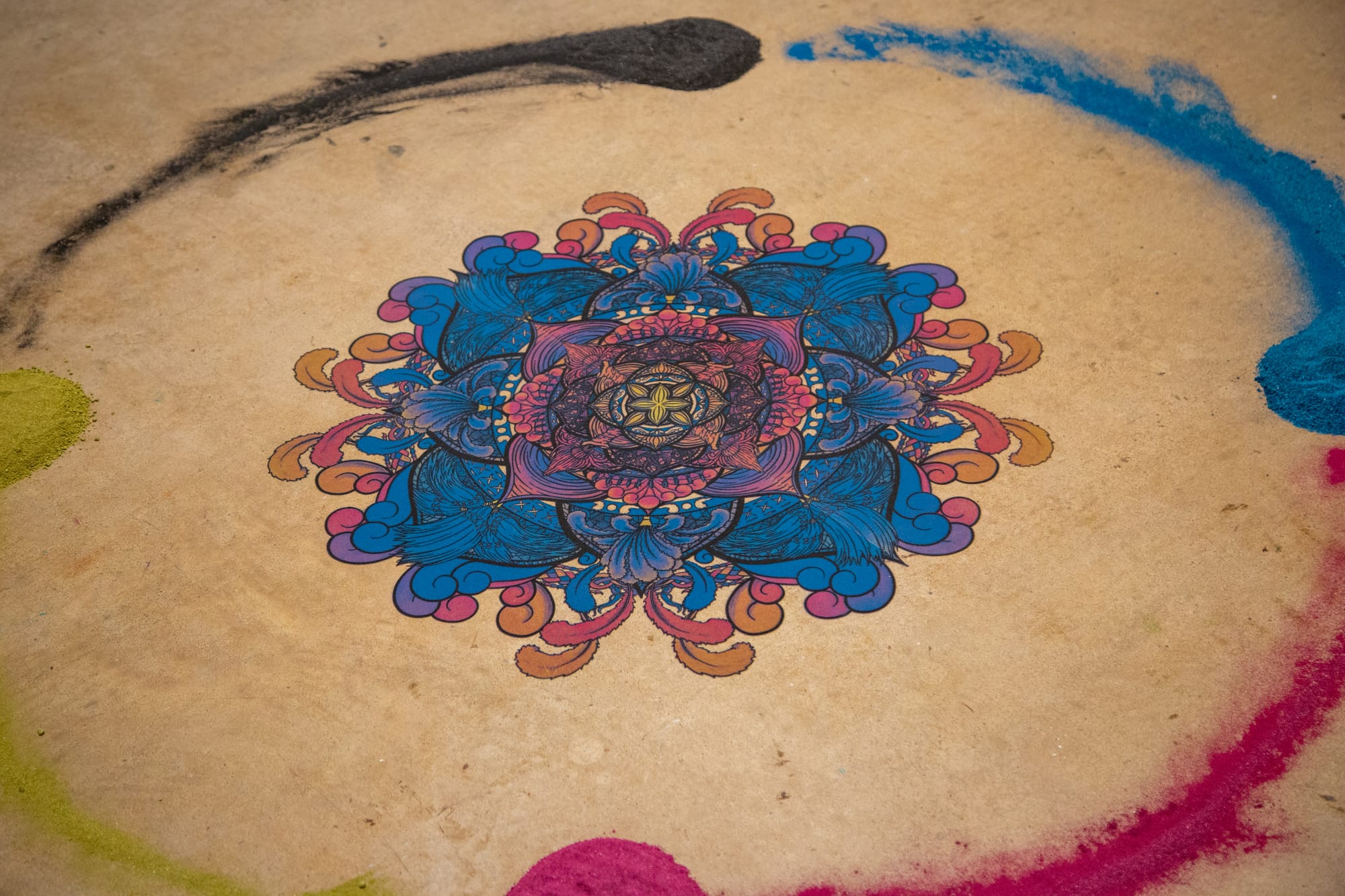
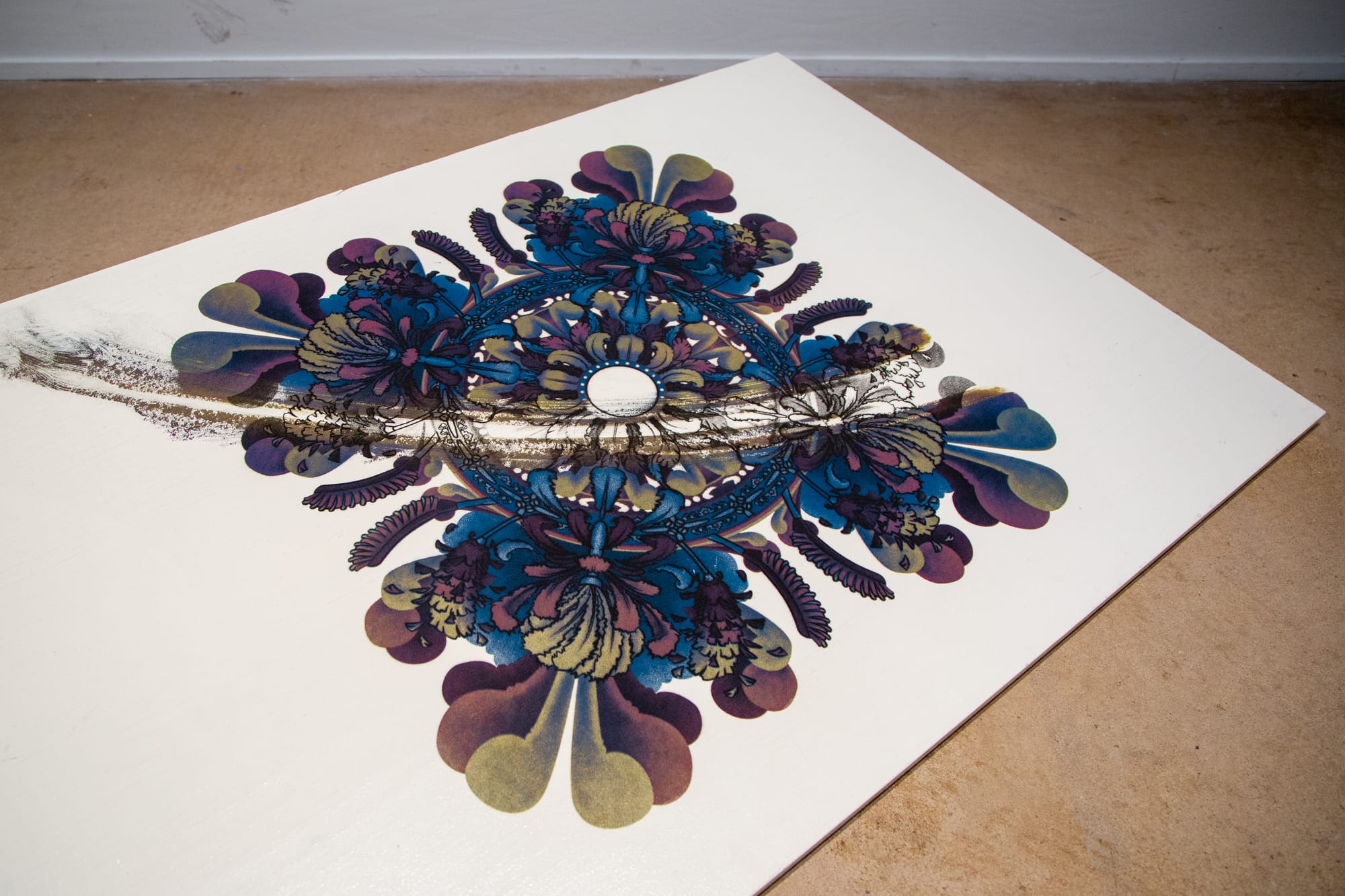
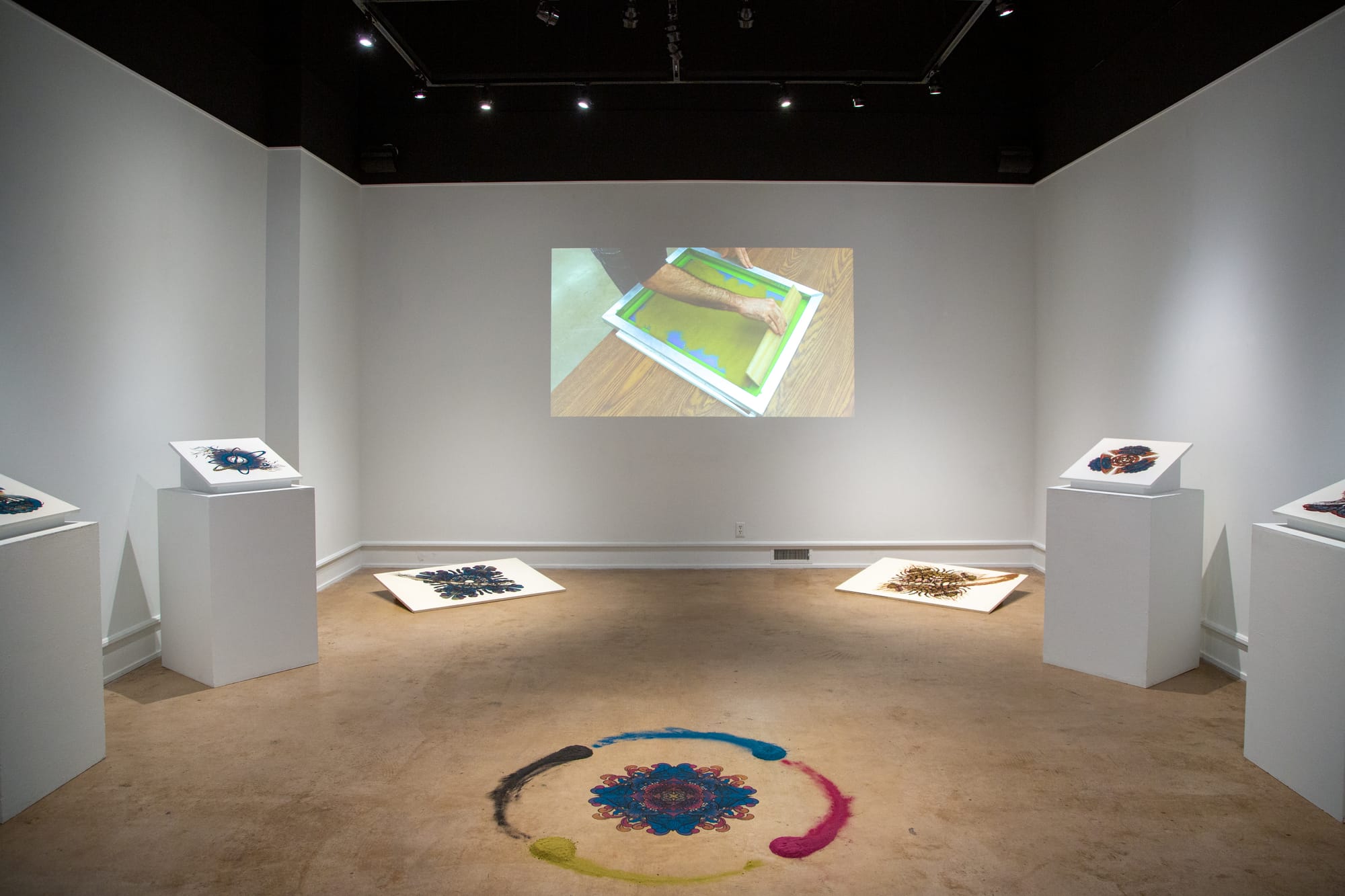
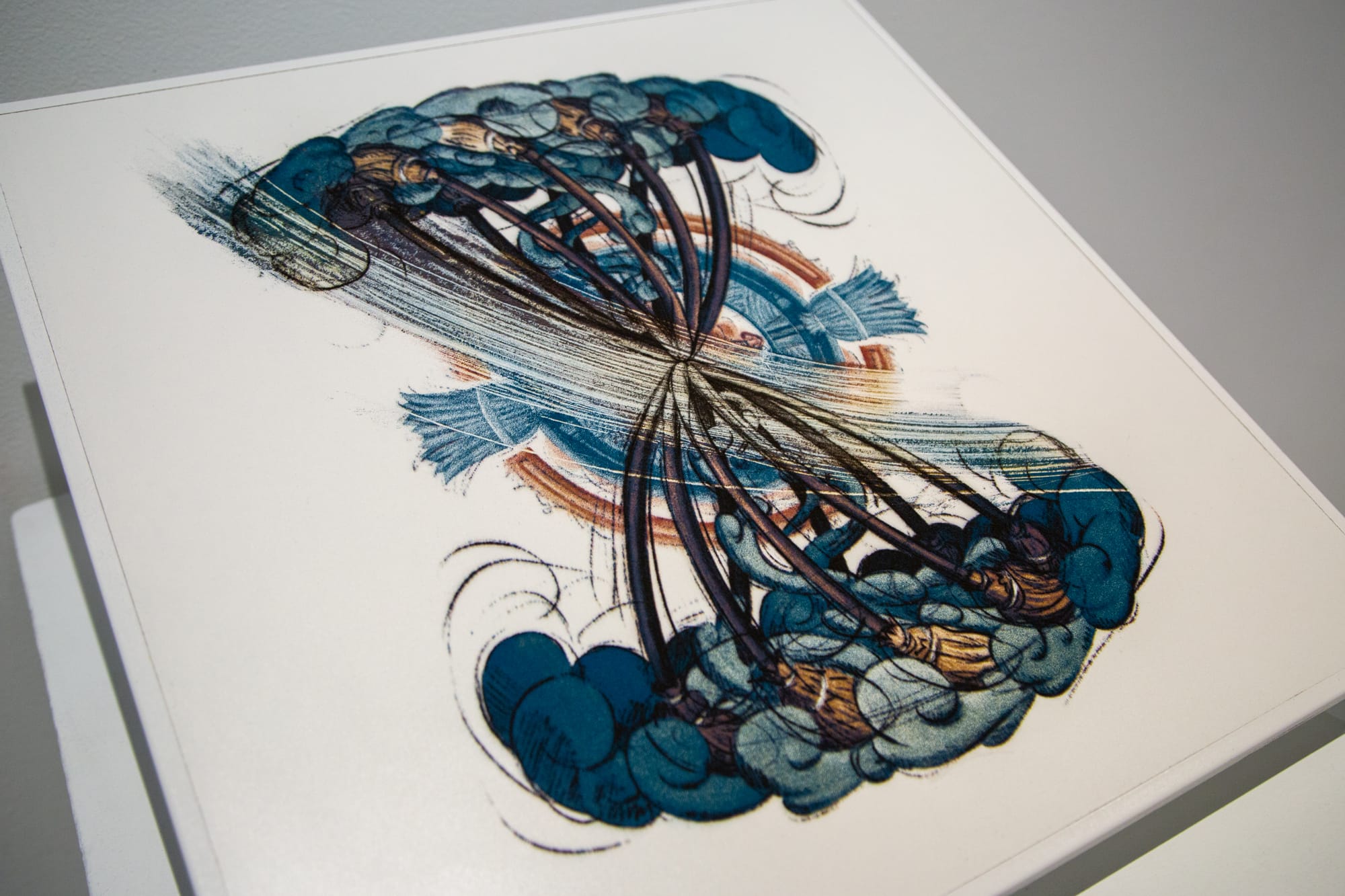
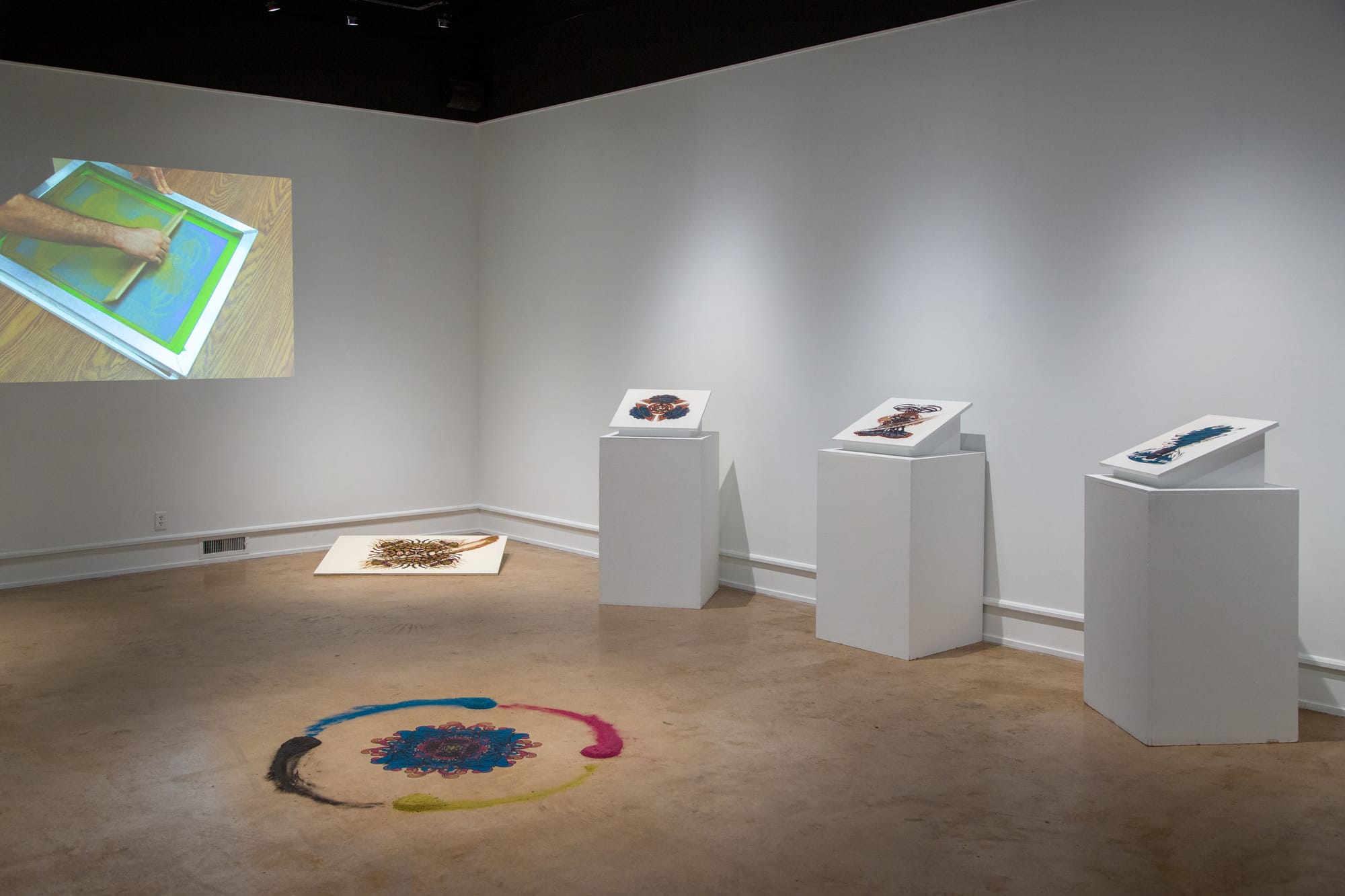
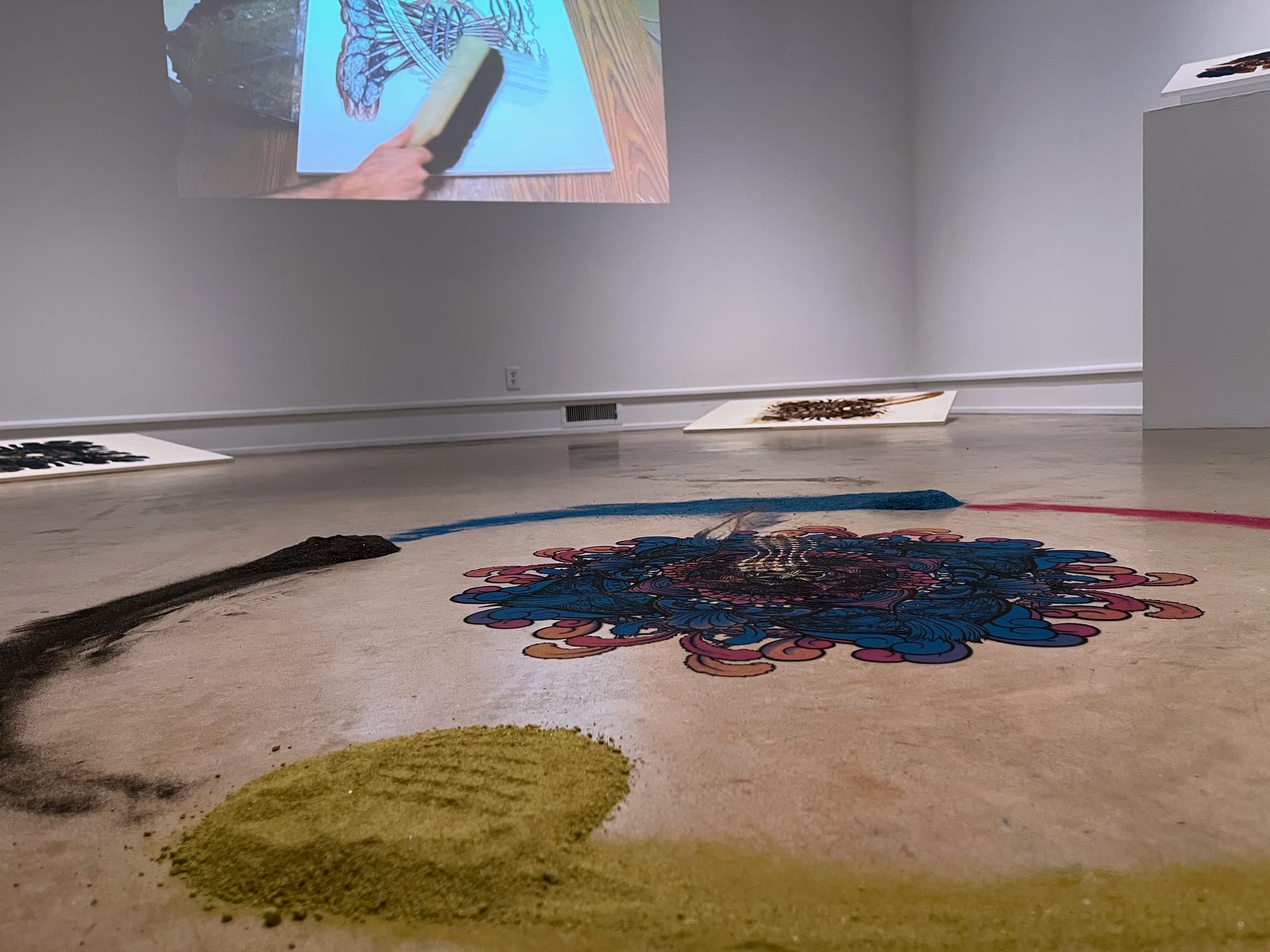
Works by Anthony Corraro from his graduate thesis exhibition "To Dust," from top left: "Nexus," dyed floor dust through silkscreen, 48 by 48 inches, 2024; "Dusting," dyed floor dust through silkscreen, 26 by 26 inches, 2023; installation view of "To Dust," including "The Process," video, 2024; "Sweep," dyed floor dust through silkscreen, 17 by 15 inches, 2023; another installation view; by the exhibition's close, someone had left footprints in "Nexus." The first five photos are courtesy of the WSU School of Art, Design and Creative Industries.
Note: Wichita State graduate student Juan Gallardo will present his Master of Fine Arts thesis show at Harvester Arts in May. Look for a review of his exhibition next month.
Emily Christensen is a freelance journalist and news entrepreneur based in Wichita, Kansas. She is the co-founder of the SHOUT.
Support Kansas arts writing
The SHOUT is a Wichita-based independent newsroom focused on artists living and working in Kansas. We're partly supported by the generosity of our readers, and every dollar we receive goes directly into the pocket of a contributing writer, editor, or photographer. Click here to support our work with a tax-deductible donation.
❋ Derby man has the kind of voice that turns heads — and chairs
❋ Socializing while sober: how some Wichitans are cultivating alcohol-free communities
❋ As a small creative business closes, the owner mourns
❋ Painting through it: Autumn Noire on 20 years of making art
❋ How a guy from Wichita resurrected 'Dawn of the Dead'
❋ Bygone Friends University museum housed curious collections



